Contributed by: filbert Wednesday, January 30 2013 @ 10:38 PM CST
Month: January 2013
The School Cafeteria Song
Contributed by: filbert Sunday, January 27 2013 @ 06:50 PM CST
Remembered one evening, sitting around in my sister’s living room:
Great green globs of greasy, grimy gopher guts,
Mutilated monkey meat,
French fried parakeet;
Lukewarm vomit floating in my orange juice,
That’s what we’re having today!
The 2012 Hong Kong-Athens Cruise, part 6 of 6
Contributed by: filbert Sunday, January 27 2013 @ 08:00 AM CST
Text and pictures by Snookums, webification by Filbert
Part Six
May 11 (Friday, Day 36, Haifa, Israel; 1 ILS = $0.26; $1 = 3.79 ILS) –
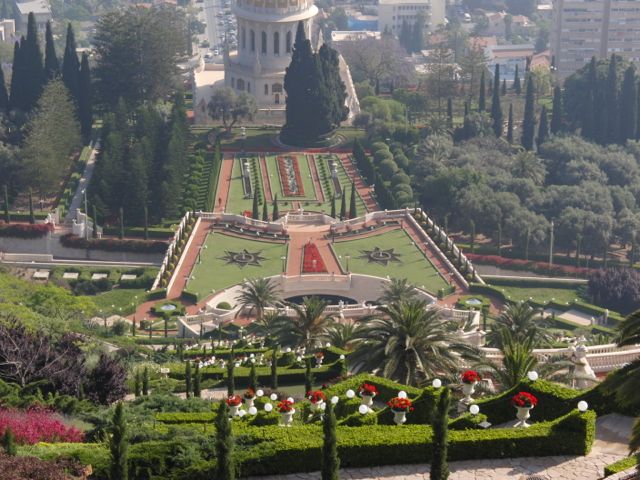 |
| Baha’i Gardens |
At 8 AM the six of us met Omri to start our day seeing the Christian highlights. We started off by driving to the top of Haifa’s Carmel Mountain for a panoramic view over Haifa bay and the famous Baha’i Gardens. Haifa is Israel’s largest port and third-largest city. The most striking landmark on the mountainside is the gleaming golden dome of the Baha’i Shrine, set amid utterly beautiful circular grass terraces that fill the slopes from top to bottom. Haifa is the world center for the Baha’i faith. Then we drove along the plains of Armageddon to Nazareth – the place where Jesus spent his early years. In Nazareth, we explored the Basilica of the Annunciation, one of Christianity’s most revered shrines and largest church in the Middle East. The Nigerian group that we saw yesterday was at this church today! We walked next door to the Church of St. Joseph and it was built over the cave where Joseph did his carpentry. Nazareth was a cave village so most of the historical sites are built with the historical caves in the bottom of them. In recent times, Nazareth used to be a majority Christian city but is now mostly Muslim since the Muslims are having more children than the Christians.
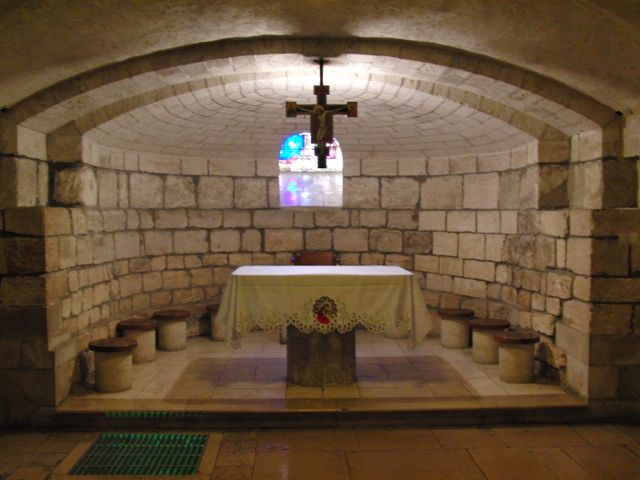 |
| Under the Church of St. Joseph |
Then we drove through Cana, the place where Jesus performed his first miracle of turning water into wine. It is now a primarily Muslim community and all of the gift stores were selling Cana Wedding Wine.
We stopped at a Sea of Galilee overlook and it looks like a big lake. Omri’s mother-in-law lives in a kibbutz so he drove us through Kinneret Kibbutz. She works in the accounting department. Kibbutz’s used to be like communes where everything was shared and the children were taken from their parents. Today people can buy their own cars and the children stay with their families. Omri was born in a kibbutz, but his parents left when they realized that he wouldn’t be growing up with them. Omri’s wife grew up in one and wants to live in one, but Omri and their two children do not. Their children go to the school at the mother-in-law’s kibbutz, though, since it is better than the local school. The kibbutz that we drove through has a dairy, a plastics factory and a date farm.
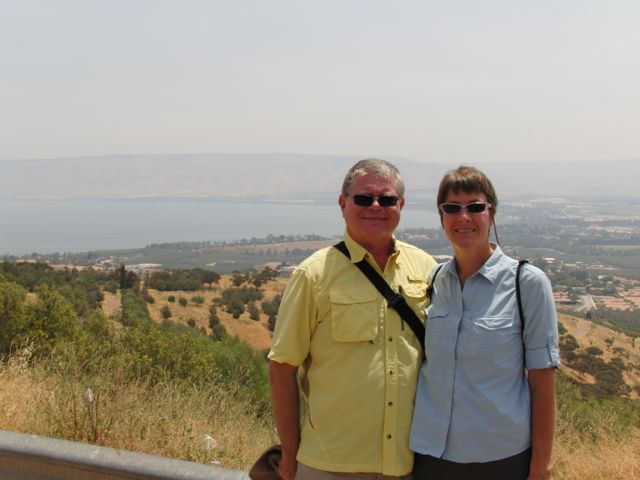 |
| Overlooking the Sea of Galilee |
Then we drove to the Yardenit baptismal site where the River Jordan separates from the Sea of Galilee. The River Jordan is where John baptized Jesus. Pilgrims from around the world come to perform baptismal ceremonies and we saw several people being baptized when they walked in the river. It is a very small river. Nutria were swimming in it. The Kinneret Kibbutz owns the Yardenit site. It was free to enter, but everything else cost money, including the bathroom ($0.50). It generates a lot of money for the kibbutz and Omri knows this since his mother-in-law works in accounting.
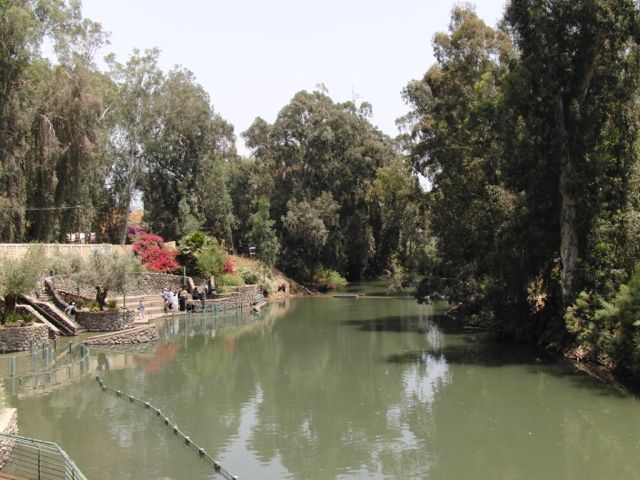 |
| The River Jordan |
We drove by the Mary Magdalene excavation. It is closed to the public but they are trying to raise funds to build it.
Then we went to lunch. We pulled up to what looked like a truck stop and the sign on the top said “Oriental Restaurant”. Omri said that even though tour buses stop at this restaurant, he brings his family here. We were game, but Snookums was thinking “No, not Chinese!”. John and Ronnie opted to not eat lunch since they rarely eat lunch on the ship. So Omri and the four of us sat down. Then Snookums saw that the menu was for a Lebanese restaurant and she was psyched. Omri suggested we just start with the salads and we agreed. The next thing we knew, out came ten or twelve plates of cold salads! Barbara saw that arak was on the menu. Arak is a licorice-flavored liqueur (like ouzo). She was thrilled and ordered the $5.75 version from the five brands listed on the menu. Filbert couldn’t be outdone and he also ordered a glass of the other $5.75 kind. In the excitement of tasting all of the salads, plus the pita bread and the toasted pita bread, Filbert and Barbara forgot to do a taste test of their araks and will never know which brand was better. Filbert thought that the liqueur did complement the meal quite nicely. The bill for the meal was $90 and we split it down the middle since we wanted to treat Omri. (Although $45/couple sounds like a lot for lunch, the tour information did say that around $20 per person should be brought for lunch each day.) One of the salads was tabbouleh but this version was 99% parsley and 1% couscous. We managed to finish at least four of the plates (including a tomato sauce/salsa-type salad, tuna salad, hummus, and goat cheese salad) and thought we were done. However, out came the bronze ethnic coffee pot with tiny cups and a plate of fresh dates. Fresh dates are not as sweet as dried dates, but are very similar.
After lunch, we went to Tabgha, the site of the miracle of loaves and fishes. There is a church there now. Then we visited Capernaum ($0.80) which is located on the beautiful shores of the Sea of Galilee. Capernaum is considered the center of Jesus’ ministry while he was living in this area. We saw the ruins of an ancient synagogue where an impressive mosaic floor was recently discovered. We also saw the ruins of Simon Peter’s home.
Then we drove to the Mount of Beatitudes where Jesus preached the famous Sermon on the Mount. This was a gorgeous place with lots of flowering trees and shrubs and looked like a resort.
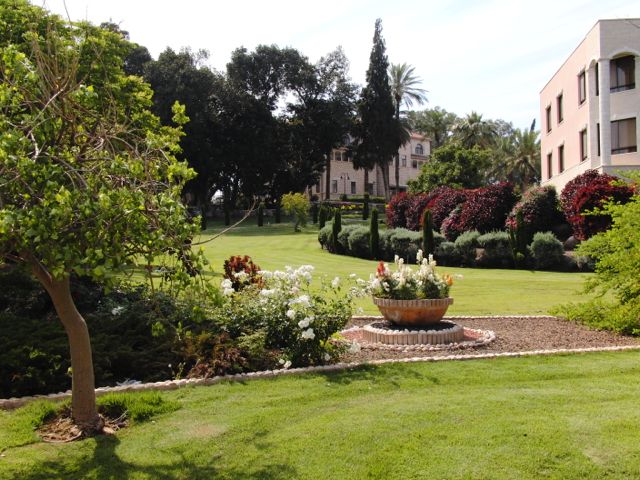 |
| The Mount of the Beatitudes |
After that, we drove back to Haifa and got on the ship around 5:00 PM. We drove all over Israel and saw a lot of its land. It is very hilly and has a lot of agriculture. It looks a lot like California. We also saw the walls that block off Palestinian territories from the rest of Israel. They looked very much like the Berlin wall since they were very tall and had barbed wire at the top. Due to the suicide bombers several years ago, Palestinians are not allowed to travel throughout Israel without permission, which is not easy to get. In fact, the security in Israel is higher than any of place we visited on this cruise. Random searches took place as passengers were getting on and off the ship and our bags were checked before going to the Wailing Wall. We had to pass through metal detectors, too. It’s just a way of life in Israel and Omri said he doesn’t even think about it and is not fearful. We had a great day for $130 per person, excluding lunch. The ship was charging $149 for its tour and it included lunch, but our tour group of six was much smaller and our lunch was outstanding.
Filbert still hadn’t received the lost/stolen form so we asked about it at the Front Desk and was told it would be delivered. This was another example of Oceania’s incompetence (and most of the incidents did not make it into this journal).
Snookums did laundry and some moron took our clothes out of the dryer before they were dry. The dryers rarely stop, either, so the “in use” light was on and the person took them out and dumped them in a laundry basket which meant lots of wrinkled clothes. Snookums plans on washing all of our clothes when we get home anyway, but it would have been nice to have wrinkle-free clothes for the last few days. (We brought around four outfits each so there aren’t a lot of clothes to wash.)
May 12 (Saturday, Day 37, Haifa, Israel; 1 ILS = $0.26; $1 = 3.79 ILS) –
We woke up and took the 10 AM shuttle to downtown Haifa. We decided to go up to the Baha’i shrine, or the Shrine of the Bab, and started our hike. After walking up many, many, many stairs for ¼ mile (that doesn’t sound that far, but when it is almost straight up, it is!) that are located outside the Baha’i property, we were at the shrine and the surrounding gardens. The gardens are 19 stunningly landscaped terraces that are a harmony of color and form – pale pink-and-grey-stone flights of stairs and carved urns overflowing with bright red geraniums set off the perfect cutouts of emerald green grass and floral borders. Haifa is the world center for the Baha’i faith, founded in Iran in the 19th century. It holds as its central belief the unity of mankind.
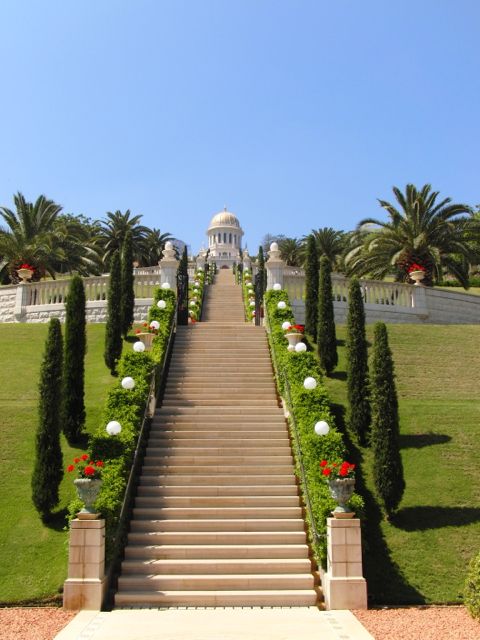 |
| Shrine of the Bab |
We walked around the gardens and made our way to the Shrine of the Bab. We removed our shoes and walked in and no cameras were allowed. It was disappointing, to say the least. There were assorted Persian carpets on the floor and no interesting or ornate decorations on the white walls or ceiling. There were some chandeliers and then the “altar” or “shrine” part of it contained a bunch of candelabras of differing sizes and some cloisonné bowls. There didn’t seem to be any rhyme or reason to these items. Some candelabras held eight candles, some 12. It didn’t seem to matter.
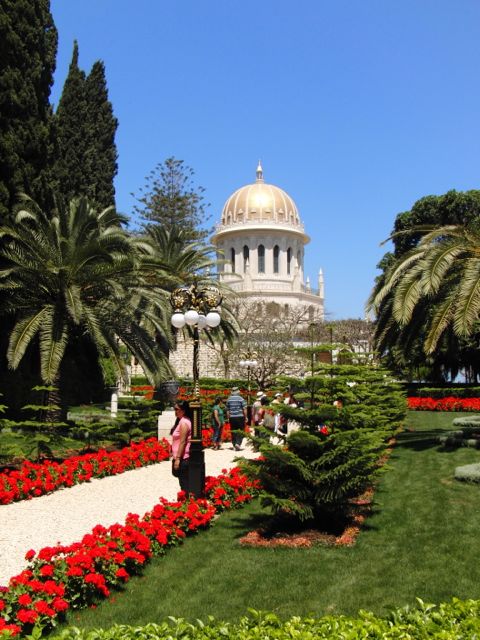 |
| At the top of the gardens |
We were hoping to buy a painting for our travel wall since we buy one on each trip as a souvenir. However, we hadn’t seen any at Petra, Wadi Rum or Jerusalem. We thought for sure we would find one of the Baha’i Gardens, but we didn’t. There was not a souvenir store or even an information kiosk. The Baha’i could raise a lot of money by having brochures, postcards, souvenirs and water for sale. But, there is nothing for sale and no information at all in the entire complex. There are security guards and that is all. No explanatory signs or anything. We’ll have to frame one of Filbert’s photos.
When we saw all that we could, we decided to walk back down to the shuttle stop a different way. Most of the stores were closed since it was still the Sabbath. However, we managed to find a Russian grocery store and since Filbert still had a ten-shekel coin ($2.50) in his pocket, we had to spend it. (Immigrants from the former Soviet Union make up 25% of Haifa’s population.) There was a huge selection of foreign beer, wine and liquor. We could have purchased all sorts of Russian things (chocolate, jam, vodka) in addition to normal items found in other Israeli grocery stores. We ended up buying a Coke Zero ($1.50) for Filbert and an $0.80 pound cake pastry with jam filling for Snookums. We were left with $0.20 and Snookums found the one cashier that spoke English (everyone spoke Russian) and asked if there was anything we could buy for it and was told “no”. She gave the $0.20 to the cashier.
Prices in Israel seem to be similar to the U.S. A 20 oz. can of tomatoes cost $0.87. 0.8 gallon of milk is almost $5. Gasoline is around $7/gallon. A 4 oz. can of tuna is $2.50.
We made it back to the shuttle stop and took the 1:30 shuttle back to the ship. We were very hot and tired and definitely got our exercise for the day!
When we got back to our cabin we saw that the wood railing on our veranda had been varnished and there was also a 1½ liter bottle of Caffeine Free Diet Coke on the desk. (Snookums was told that it had run out on May 5 and she strongly suggested they look in every port for it. Oceania finally found some on the third day we were in port. Better late than never??)
We received a call from the purser around 5 PM saying that our onboard account would be credited $50 for the sleep apnea face mask that housekeeping lost on May 5th. That issue took way too long to resolve, too.
We enjoyed happy hour with Barbara and Donna followed by dinner. They are fun traveling companions. And when Donna gets her new knees, watch out!
May 13 (Sunday, Day 38, Cruising the Mediterranean Sea) –
During this entire cruise we haven’t seen much sea life. We saw dolphins three or four times and lots of flying fish. When we were in the Red Sea we saw 1000s (and this is not an exaggeration) of pink jellyfish that were around 8” in diameter. We saw a couple of sea turtles and a shark, too, during the cruise. All in all, though, there wasn’t much sea life.
We met Barbara and Donna for happy hour (every night from 5 – 6 drinks are two-for-one in some of the bars) and then had a very nice dinner with them in the Grand Dining Room. After that it was time to pack.
May 14 (Monday, Day 39, Athens (Piraeus), Greece) –
We woke up, showered, picked up our passports and ate a leisurely breakfast. We weren’t meeting the George’s Taxi van service until 8:50 AM and it seemed that most people were getting off the ship around 8 AM so breakfast was not busy at all. Oceania requests that all passengers vacate their cabins by 8 AM and all passengers must disembark by 9 AM. (Holland America lets passengers remain in their cabins until they disembark.) After cruising 8,203 nautical miles over 35 days, we got off the ship for the last time, found our luggage, walked through passport control and customs and found the van and six other passengers. One hour later and $55 total, including tip, for the two of us, we were at the Athens airport. (Oceania was charging $79 per person for its transfer service.)
We got to the gate three hours prior to our departure but that was okay. We used the free WiFi and relaxed. Snookums was happy since she was able to buy a liter of water for $0.88 which is the cheapest she has ever paid at an airport. Filbert’s two small Coke Zeros were $3 each.
Our 1:05 PM flight from Athens to Munich was on time and Lufthansa served a hot meal. It would be nice if US airlines served hot meals, or any meals, on flights that were only two hours and 35 minutes long! And, the meal of meatballs in a tomato sauce served on rice was quite tasty. Snookums told Filbert that this meal had more flavor than any of the Oceania meals and he readily agreed. Sad, but true.
We landed in Munich with one hour to catch our flight to Chicago. Unfortunately, the Munich airport is very large and going through passport control and security took a long time. Snookums made a quick stop at a store to buy water ($4.33) while Filbert kept going ahead. We both made it to the gate and the gate agents were yelling for Chicago passengers. However, there was one more security checkpoint to get through and around ten of us were in a single file waiting to walk through the metal detector and then succumbing to a manual search. The plane waited for all of us.
During the 9 hour and 45 minute flight to Chicago Snookums got a sore throat. Other than that, it was uneventful. The O’Hare passport control lines were the longest we had seen there but we finally made it through and got our luggage. Then we climbed on the tram to the other terminal and made it to the gate with about 5 minutes to spare before boarding the flight to Kansas City. Today was a day of just barely enough time to make connections.
All of our luggage made it to KCI and our van driver was waiting for us. We got home around 10:30 PM, made sure everything was still in working order, showered and went to bed around 11:15 PM.
Snookums woke up on Tuesday with an awful sore throat as well as crusty eyes and no energy or appetite. She ultimately went to the doctor later in the week and had a blood test for malaria which was negative, as was everything else. The doctor said she had a virus. The sore throat, crusty eyes and lack of energy lasted for a full 14 days. She lost 10 pounds during those 14 days (but that was after gaining four pounds on the cruise while Filbert gained one pound)!
Final Impressions
Things we liked about Oceania:
Afternoon tea was very good.
The pizza was the best cruise pizza, but that’s not saying a whole lot.
The French toast and breakfast fresh fruit selection were great.
The sticky buns that were served on some mornings were great.
The bed and sheets were very comfortable.
There is no onboard photographer hassling you about taking your photo.
Things we disliked about Oceania:
The cabins were very small.
The soft drink selection included only one kind of diet soda – Coke Light.
There were only four washing machines and four dryers for 650 passengers.
Every bingo session announcement came to every cabin if the TV was on.
After 2 PM, the only lunch option was the outside grill with its set menu.
Requesting sandwich bread or yellow mustard at the Terrace Café during lunch or dinner was regarded as a major hassle.
The salad bar was very limited with five items per day in addition to mixed greens and it was not self-serve.
Dinner entrees and appetizers were frequently repeated.
The food was very bland, including the ethnic dishes.
The crew was from many countries which made communication difficult.
Terrace Café service was poor – not enough buffet servers, not enough wait staff refilling water glasses.
The medical doctor that Snookums saw on the ship was incompetent.
The special ordered Coke Zero was delivered late and then supposedly ran out for three days. Caffeine Free Diet Coke ran out with eight days to go.
The 2012 Hong Kong-Athens Cruise, part 5 of 6
Contributed by: filbert Saturday, January 26 2013 @ 08:00 AM CST
Text and pictures by Snookums, webification by Filbert
Part Five
May 7 (Monday, Day 32, Safaga, Egypt continued) –
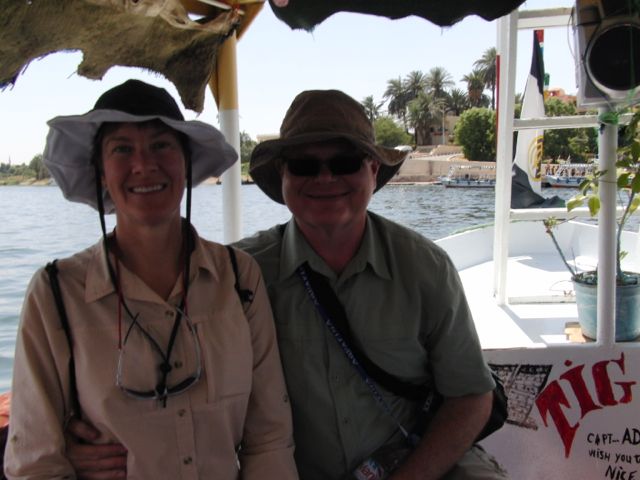 |
| Crossing the Nile |
We drove to an air-conditioned alabaster shop in order to drop Donna off since she decided she was kind of done for the day due to the heat and the need for two knee replacements. The rest of us continued on to the Valley of the Kings ($13.25 per person). This is a valley that contains a lot of tombs that were built for the pharaohs and noble from the 16th to 11th centuries BC. It is most famous for the tomb of Tutankhaman. We saw the tombs of Ramses 1, 9 and 4. Of the three, Ramses 1 was buried the farthest underground and there were quite a few steps and then a ramp to navigate to get to it. The ticket puncher at the entrance gave Filbert a flashlight and helped Barbara down all the steps and ramp. Then he pointed at various paintings/figures on the tomb and told us about them. We were pretty glazed over by that time. We started up the stairs and he expected a tip. We walked by him and ignored him. We didn’t ask for the flashlight or the help down the stairs! We forgot that in Egypt just about everyone expects a tip (or baksheesh). Cameras weren’t allowed in the tombs (all underground, but still hot and stuffy) since the colors could be damaged by flash photography. Barbara went back and waited in the visitors’ center after going to the first tomb but Filbert and Snookums saw all three. (A ticket allowed entrance to three tombs.) There are many tombs and our guide chose these three for us to see. Other tourists were seeing other tombs. We went back to the alabaster shop to get Donna and Barbara bought an alabaster cat since she figured they needed to buy something since Donna was being “hosted” for an hour. Then we all went to Queen Hatshepsut’s Temple ($5.00 per person). From a distance, this temple looked like a 1970s-era government building with three stories and a lot of windows. Filbert and Snookums were the only ones that climbed the steps to see this temple. After this quick visit, we all got back in the van and headed to Colossi of Memnon for a quick photo stop of these two huge statues. Then we had a 15-minute drive to the Steigenberger Nile Palace Luxor hotel. We got a top floor room with a great view of the Nile River. We sat on the balcony for a little while and watched the felucca boats sailing on the Nile and looked at the farms on the other side. It was very pretty and peaceful. The hotel was a beautiful 5-star hotel and the bathroom even had a bidet in it!
Filbert and Snookums decided to take a quick stroll around the hotel and tried three ATMs before finding one that worked. Then we went to the little grocery store next door. Snookums bought a can of Diet 7-Up and Filbert bought a larger bottle of Coke Zero. They were each $0.83. Filbert had been thinking he had a sinus infection so we went to the pharmacy in the hotel and Filbert bought a box of five 500 mg azithromycin pills for $22. (The standard U.S. dose is 250 mg for five days.) Then we went to our room and relaxed.
The four of us decided to eat dinner at the Thai restaurant in the hotel. Reviews on TripAdvisor said that it was the best restaurant of the four in the hotel and it was very good. The chef was actually from Thailand. Filbert and Snookums enjoyed their entrees and Filbert’s two beers (alcohol is really only available in luxury hotels in the Muslim country of Egypt and each beer cost $5.50) for around $45. (The hotel prices matched prices in a Hyatt in the U.S. It seems that regardless of where you are in the world, if you stay in a very nice Western hotel, you’ll pay U.S. prices!) The two of us probably could have eaten like kings at a restaurant down the street for $15 but we were tired and didn’t want to deal with “Egypt” so we were willing to pay for the ease of eating in the luxury hotel.
After dinner we went back to our room and sat on the balcony and saw that the Theban Hills on the Nile’s west bank were lit. It was beautiful and we sat outside for awhile before deciding that we were pooped. Our lights were out by 10 PM! Our guide told us that around two years ago the various temples and antiquities started being lit at night when Luxor became its own governorate. Luxor has a population of around 150,000 and enjoys more autonomy than other areas of Egypt.
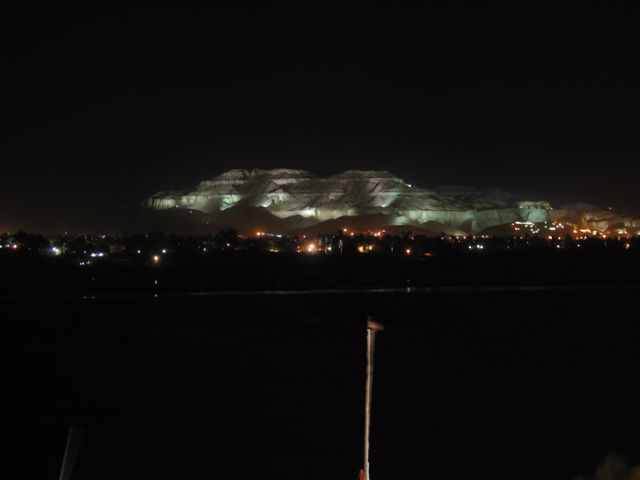 |
| Theban Hills at night from across the Nile |
May 8 (Tuesday, Day 33, Safaga, Egypt; 1 EGP = $0.17; $1 = 6.04 EGP) –
We woke up at 6 AM and went out on the balcony and saw the hot air balloons that were taking tourists on rides to see the sights. We showered, ate at the included breakfast buffet and got in the van at 7:30 AM. Then we drove to Luxor Temple ($8.25 per person) and all four of us enjoyed walking around this smaller temple that was built between 1390 and 323 BC. We also really enjoyed the morning’s cooler temperature. Around 8:30 AM we said goodbye to Amr and our driver took us back to Safaga.
We learned that the driver dropped people off at hotels at 10:30 PM last night and then went to get gas for the van. He waited in a long gas line and didn’t get home until 2:30 AM. He woke up at 5:30 AM so only slept for three hours. Twenty minutes into the drive the driver stopped at a little roadside store and we could see that he was buying various packages of junk food. He got back in the van and we asked him if it was his breakfast and he said “yes” and then gave each of us a Twinkie. Snookums was thrilled and told Barbara and Donna that she used to get Twinkies and PopTarts and stuff like that for birthdays when she was younger and actually just got SnoBalls for her 48th birthday from one of her sisters. Filbert, Barbara and Donna each gave Snookums their Twinkies. She ate two of them but there really wasn’t any cream filling in them even though the package clearly showed it on the photo.
We stopped at the only tourist stop between Luxor and Safaga and Filbert bought two 1-liter bottles of Coke Zero for $8.25 (yes, they were horribly overpriced) AND gave the vendor a $1 tip! He is such a softy. (Three days ago our cabin stewardess told us that the ship didn’t have any more Caffeine Free Diet Coke or Coke Zero. We left a note for the Executive Concierge that we expected Oceania to get us some in Safaga, but we’re not counting on it.) We pulled up to the ship around 11:45 and saw a bunch of Egyptians with tons of luggage leaving the port. We noticed two shabby cruise ships in port, too. Our driver said that the two ships came from Saudi Arabia which is about 24 hours away. The people were coming from their trip to Mecca and our driver said that they probably were there 30 days. That explained the huge amounts of luggage that the families had.
The price for the four of us was $220 each for our overnight Luxor tour with Ramses Tour Egypt which included everything except for dinner. The ship was charging $219 per person for the 1-day Luxor tour. That would have meant seven hours of driving in one day on a bus full of people to see just some of the things we saw. For Snookums, the night in the hotel overlooking the Nile was the main highlight of the Luxor trip.
We ate dinner at Toscana, the reservations-only Italian restaurant, and really enjoyed the food. The third time’s the charm!
May 9 (Wednesday, Day 34, Suez Canal Transit) –
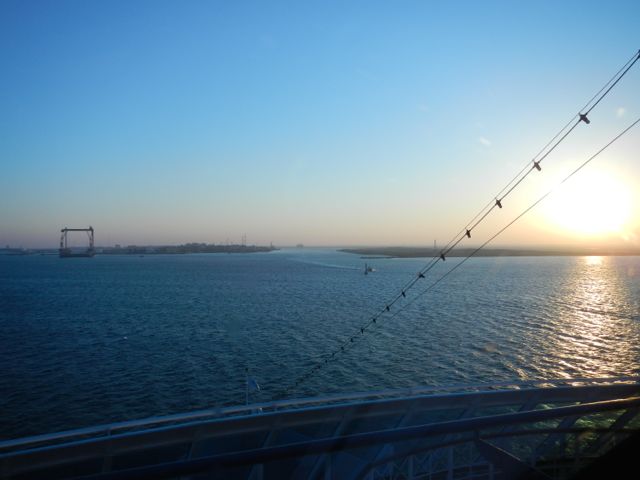 |
| Entering the Suez Canal |
Filbert woke up around 4:30 AM and went up to Horizons to see the Suez Canal. Snookums joined him around 6. It was cool and clear. Most of the day was spent on the veranda during our 11-hour canal passage. Our veranda faced the Sinai Peninsula side of the canal which was mostly desert with a solitary soldier stationed about every mile or so next to a guardhouse, a hut or even just a little tent. Around 3 PM Filbert put on long pants and a jacket since it was very cool (71°) and windy outside. Unlike the Panama Canal, the Suez Canal doesn’t have any locks. It has a lake in the middle of it where there were all sorts of ships including some of the largest container ships Snookums has ever seen. There were also two war ships but we couldn’t tell their country. After the Six Day War in 1967, the canal was closed until June 5, 1975. A UN peacekeeping force has been stationed in the Sinai Peninsula since 1974. 14% of the world’s shipping passes through the Suez Canal.
About thirty minutes after we exited the canal Filbert noticed that there was a submarine in front of our ship. That was kind of cool.
One of the things that is very annoying about Oceania is that every bingo session is announced and it comes in the cabin on all of the TV stations. So, if you are watching a repeat of a lecture, it is automatically muted while the bingo announcement is made. And, on sea days there are usually two bingo sessions. Ugh……
We went to the Middle Eastern buffet tonight for dinner. The ship has had a couple of special dinner buffets, but the food really isn’t very flavorful and tonight they ran out of several items (turkey kebabs, baklava) and it took more than five minutes for the buffet to be replenished with them. Service is also quite poor at the buffet since they don’t let the guests serve anything themselves and there aren’t enough servers manning the stations which means guests just stand there and have to wait for a server to come over and pick up the serving utensil in order to serve the guest. And, it took us a long time to get our water glasses filled. We got back to the room, turned our clocks forward (which hasn’t happened too often on this cruise since we’ve been turning them back most of the time), and got ready for our big day in Jerusalem tomorrow.
May 10 (Thursday, Day 35, Haifa, Israel; 1 ILS = $0.26; $1 = 3.79 ILS) –
We met Donna, Barbara, John and Ronnie for our 10-hour tour. John and Ronnie were born in Hong Kong and immigrated to Vancouver in 1987. We met our Guided Tours Israel guide, Omri, and got in his Land Rover, one seat per person, and headed towards Jerusalem, two hours from Haifa for our $150 per person 10-hour tour. (We were supposed to dock in Ashdod which is closer to Jerusalem, but due to Gaza launching a rocket a few months ago that landed near Ashdod, the ship docked at Haifa instead.)
We stopped at the Mt. of Olives overlook and had a wonderful view of Jerusalem, including the beautiful gold Dome of the Rock, which is Muslim, and the walls of the Old City. Jerusalem is a very large, hilly city. We got back in the car and drove to the Gardens of Gethsemane. Our guide literally got the closest street parking spot for this site, which is what he was able to do for the Mt. of Olives overlook, too. That is one of the benefits of not doing a bus tour. Individual cars can always get closer than huge buses. When we walked into the gardens, a man gave us an olive tree branch since the garden had 2000-year old olive trees in it. We didn’t realize it at the time, but he expected us to pay for the olive branch so we all gave them back. We also saw the rock where Mary cried. There is a church that was built in 1929 and while we were in the church, a small tour group from Nigeria started Mass (with around eight or nine priests/seminary students/brothers on the altar) and started singing and it made it extra special since the sound was so beautiful.
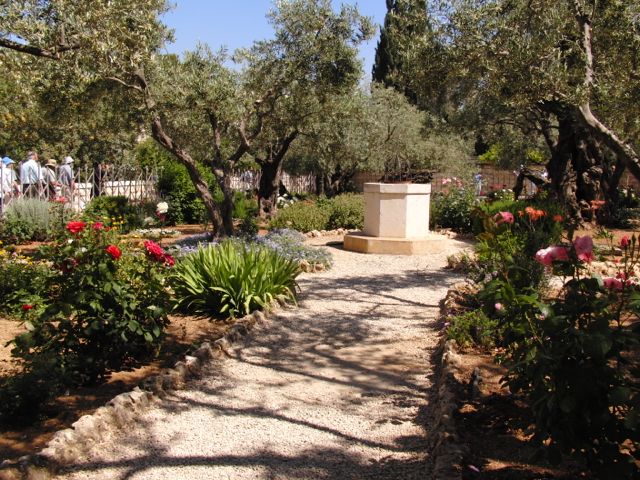 |
| Gethsemane |
We got back in the car and drove to the Old City. The streets were very crowded with local cars as well as the tour buses and it took a little while. It was strange seeing locals drive on the same streets near the Old City as all of the tourists, but the street must be one of the main ones in Jerusalem. While waiting in traffic, our guide pointed out David Citadel which was part of the Old City.
We parked in a modern underground parking lot that is used by the nice mall on top of it. We walked a block to the old city and entered through Jaffa gate. The streets were cobblestone and cars were allowed to drive on them! We walked through the city and saw a very old moat but there was never any water in it since they didn’t have any at the time (and Israel still doesn’t have much) and they used arrows and burning oil, instead.
We continued walking (and walked out of the city through the Zion Gate) and Barbara and Donna decided to wait for all of us at the King David statue, so the rest of us went upstairs to the room of the Last Supper.
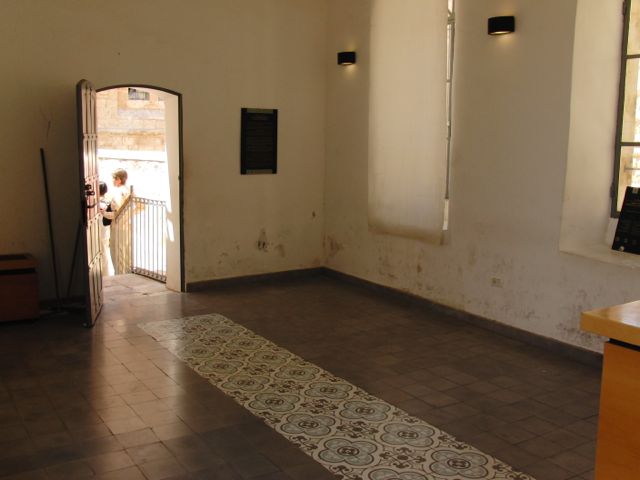 |
| Room of the Last Supper |
Then we walked to the Hagia Zion Church, which is Benedictine, and went downstairs to the crypt where Mary lived and died after the resurrection. While walking around the Old City, we saw a bar mitzvah parade. At one point the ram’s horn was blown right by Donna and she was very surprised. The parade was made up of four boys holding a canopy over the head of the honoree plus a videographer and twenty or thirty friends and family members. They were singing, clapping and carrying blue and white balloons (the same colors as the Israeli flag) and parading through the Old City. One member was carrying a basket of candies but Snookums never saw her give them away or throw them at people. Other Jewish people clapped and danced as the parade went by. It was festive.
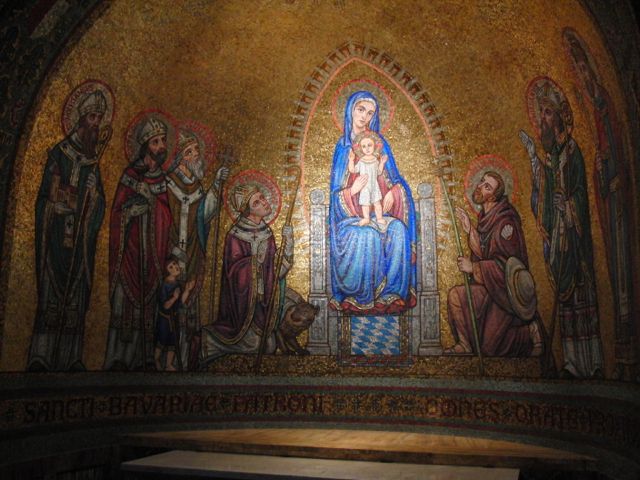 |
| In the Hagia Zion Church |
We also saw three soldiers with their rifles running around and when we saw a few more join them we got worried for a split second before Omri told us they were doing a navigation exercise and were still in training. They were not supposed to run since that scares people, but they did. Omri yelled at them but they didn’t listen. (All male and female citizens, except Orthodox Jews, have to serve three years in the Israeli military so Omri was a veteran and they should have listened to them.)
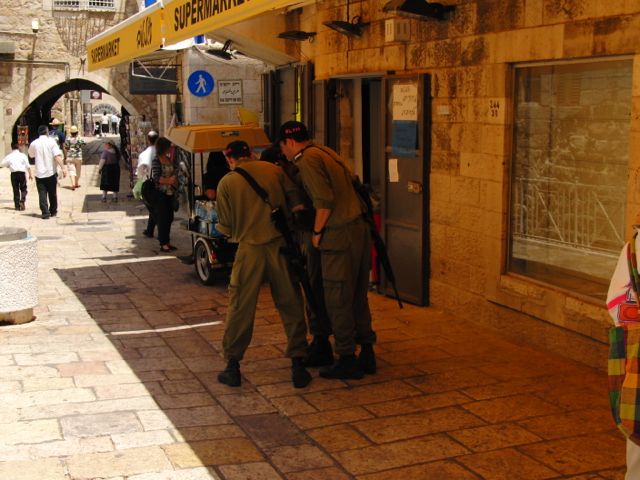 |
| Recruits |
We soon found ourselves walking on the Cardo, which means the “heart of the city” (hence cardiology). This street was from King Herrod’s time. Barbara and Donna requested a brief stop and they went to a pizza parlor to sit down and ended up having a slice of corn pizza and ice cream. Snookums went down the street (which was filled on both sides with open-air restaurants and souvenir stores) and found a working ATM. Then she bought a $0.50 postcard in order to get change while Filbert bought a $2.50 Coke Zero which also produced change (unbeknownst to her).
We continued our walk down a bunch of steps and came to another overlook where we could see the Dome of the Rock and the Mt. of Olives overlook that we stopped at in the morning. We walked down more stairs to the checkpoint to enter the Western Wall area. (By now we’ve walked about an hour on all sorts of surfaces and have walked up and down a lot of stairs. The Old City is NOT handicap-accessible!) We had to go through metal detectors and our bags went through X-ray. It was no big deal. Women that were wearing shorts were handed a free flimsy blue skirt and men without hats were given a yarmulke. The Wailing Wall was split down the middle by a divider and the women went on the right and the men went on the left. Snookums wrote her prayer on a piece of paper and stuck it in the wall. Well, it fell out of the crack and then she placed it on a little rock ledge in the wall. She figures she got twice as much for the two tries.
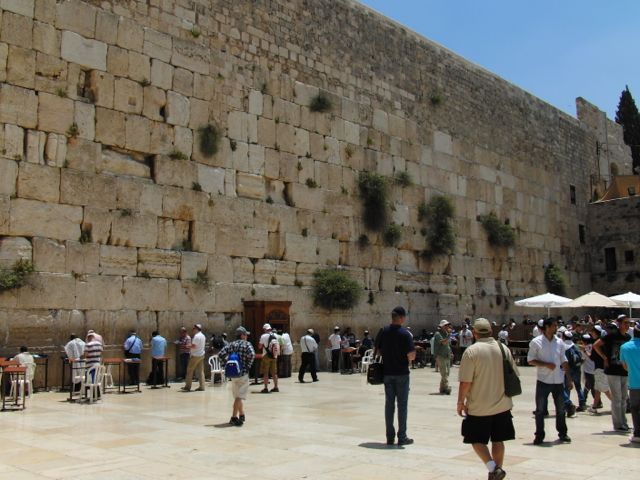 |
| The Western Wall (aka Wailing Wall) |
After we were all done at the Wailing Wall, we continued walking through the Old City through the Muslim Quarter. The shops lining the cobblestone path (which was too narrow for cars and had a lot of steps in it) seemed just like the ones in the Jewish quarter (luggage, souvenirs, socks, antiques, cafés, etc.). At one point, Omri told us we were back on the Cardo and that it separated the Muslim quarter from the Christian quarter and the Muslim stores were on one side of the cobblestones and the Christian stores were on the other, but they all looked the same.
We soon made our way to the Via Dolorosa, or Stations of the Cross. We saw the 5th, 6th and 7th stations. Each station was marked with a door and an inscription in the stone wall above the door. We had now walked for at least two hours up and down many steps and Barbara and Donna decided to stop and let the group go without them. While they were drinking $3 Cokes, the rest of us went to the Church of the Holy Sepulcher and the13th station of the cross. We also saw Jesus’ grave.
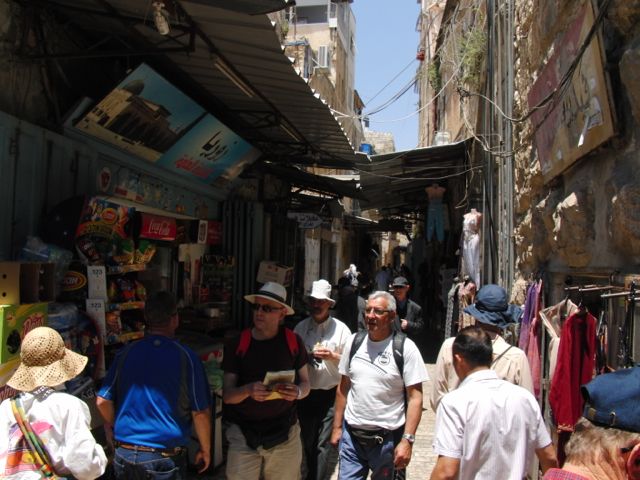 |
| The Via Dolorosa, or the Way of Suffering. Times have changed. |
We got Barbara and Donna and walked back to the car through the Old City with its cobblestone, steps and stores. Snookums bought a large donut-shaped yellow pastry for $1.75 filled with dates and shared with everyone. It was pretty good and hit the spot since it was around 1:30 by now. A street vendor was selling it as well as huge ovals (around 10 inches long and 6 inches wide) of bread that were topped with sesame seeds, called “bagels”!
When we got back to the car a local woman wanted our parking space since the underground lot was full. She was on her phone to the driver of the car she came in and was giving directions to where we were. (Of course, the conversation was in Hebrew, but it was obvious what she was doing.) Omri did a great job of getting that spot when he did.
We settled into the car for the drive to lunch and the Dead Sea, the lowest body of water on earth. We ate lunch at a typical tourist site cafeteria (Qumran Dead Sea Visitors Center & Restaurant). However, Snookums didn’t realize it was a buffet and thought that you had to pay by the item. She took the meatballs and rice. Filbert took the meatballs, mixed vegetables and schnitzel and was charged the same price ($12.00). And, there was a great salad bar but Snookums didn’t take any since she knew her entrée would be enough. When the others got to the table, that is when she learned that it was a “buffet”. That is what Snookums gets for going through the line first! Sodas were $2.50 each and Filbert’s Israeli beer was $4.35. The food was what you would expect from a tourist site – overpriced and just food. However, Omri took us here since if you eat at this restaurant you don’t have to pay $13 to use the showers and changing room at the Dead Sea stop. So, we kind of made money by eating lunch!!
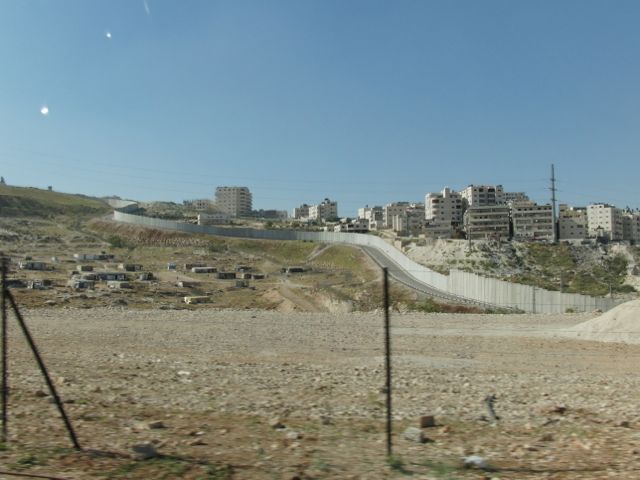 |
| The wall between Jewish Israel and Palestinian territory |
After lunch we drove a little bit more and came to a Dead Sea “day resort”. We put on our bathing suits and walked down the many steps to get to it. The Dead Sea is shrinking every year and so it keeps getting farther and farther away from the changing rooms. We had to go down a lot of stairs to reach it and Donna decided that her two knees couldn’t do it and she sat in the open-air bar area.
When we finally got to the Dead Sea, Filbert got in and started walking farther into it. One of his legs went in a hole so that his leg was submerged in this mud up to his knee. Then the same thing happened to Snookums! It didn’t hurt, but was very surprising. The bottom of the Dead Sea is very, very muddy and it is supposed to be good for the skin so we saw several people smearing the mud on their bodies. We soon realized that the Dead Sea was not getting any deeper so we decided to try our skills at floating. It is made up of 35% salt and is very easy to float. Even Snookums could do it. After a few minutes floating, we all trudged up the steps, took showers, got in the car and headed back to the ship. Arriving back to the ship around 6:30 PM never felt so good. It was a very long day with a lot of walking and we have another day with Omri tomorrow.
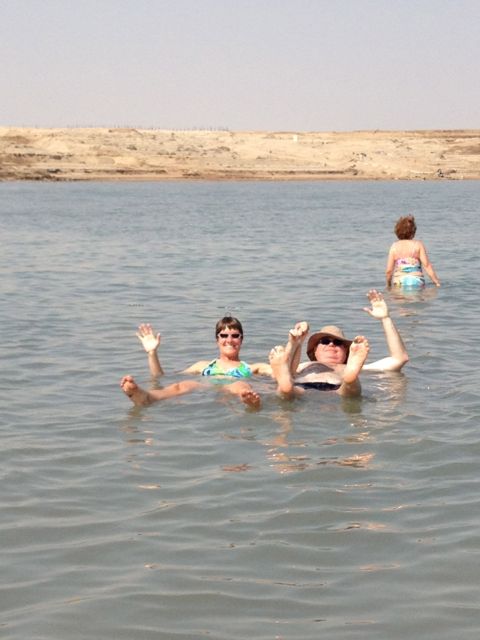 |
| Floating in the Dead Sea |
The 2012 Hong Kong-Athens Cruise, part 4 of 6
Contributed by: filbert Friday, January 25 2013 @ 08:00 AM CST
Text and pictures by Snookums, webification by Filbert
Part Four
May 6 (Sunday, Day 31, Aqaba, Jordan; continued) –
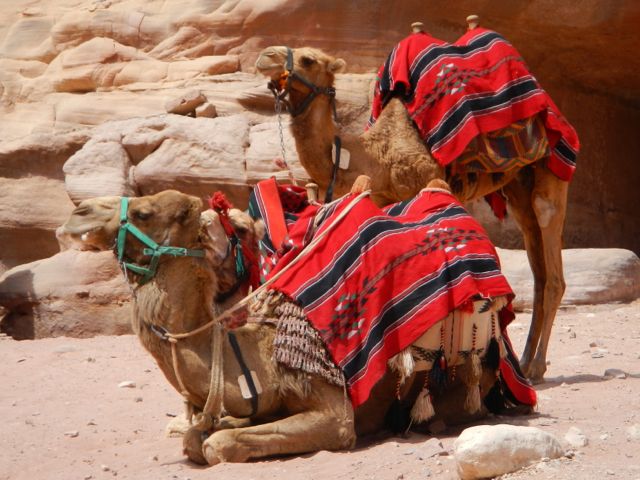 |
| We’re ships of the desert, you know. |
Another major site was the Theatre. It is carved into solid rock and can seat 7,000. Although it looks Roman, the Nabataeans built it in the 1st century AD and each seat has a seat number carved into it. (It was, however, apparently impossible to photograph — Filbert.) Ashraf asked us if we wanted to ride donkeys out of Petra to a different exit from where we came in and we all agreed and paid him $20 each. We walked around Petra and saw more of this dead city, including the 6th century AD Petra Church, until we made our way to the donkeys. If we wouldn’t have ridden the donkeys, we would have had to walk about one hour back to the beginning, retracing our steps. By riding the donkeys we got an extra 30 minutes walking around Petra and got to see other things on the way out during the 30-minute donkey ride.
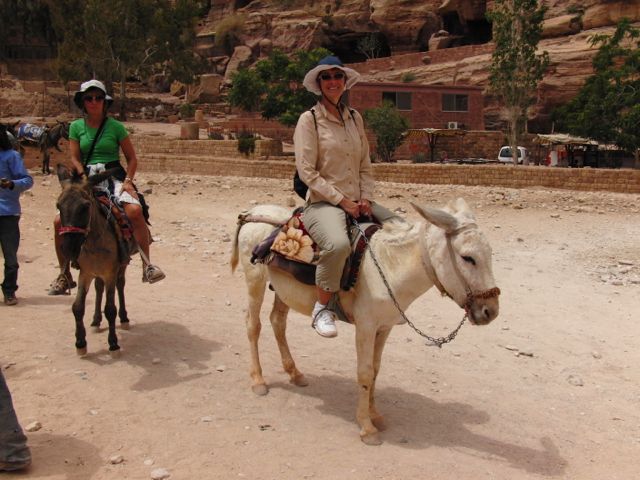 |
| Snookums and donkey |
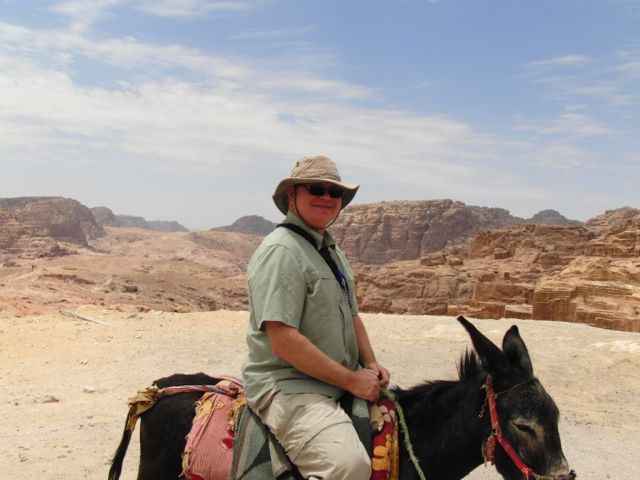 |
| Filbert and donkey |
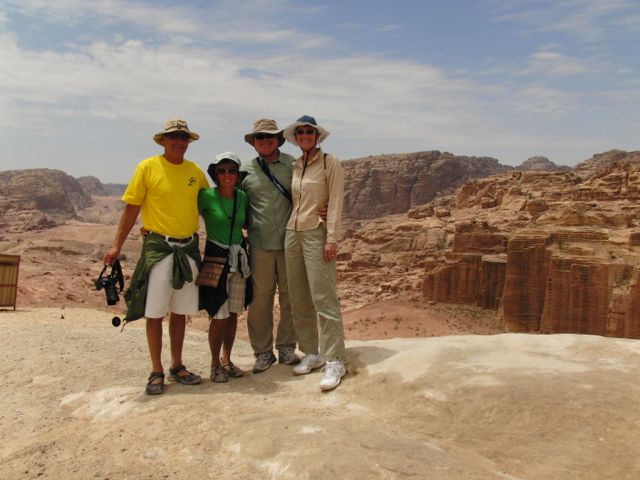 |
| The 2012 Petra Expedition |
The van picked us up at the other Petra gate and we headed to a great buffet lunch at Al Qantarah Restaurant. Ashraf said it probably cost around $18. It had a lot of cold salads, including hummus and other Middle Eastern specialties, and several excellent hot dishes like pinto beans and beef, chicken with a red sauce, lamb and fish with a yellow sauce. It also had a nice selection of desserts, including a delicious creamy bread pudding with cinnamon and raisins that is a special occasion Jordanian dessert. As a primarily Muslim country, the restaurant didn’t sell alcohol and Filbert drank a $3 can of Coke Light.
After lunch we made a quick stop at a spring that was supposedly created by Moses. Then it was off to Wadi Rum ($28 per person), around 1½ hours away. (Wadi means “dry valley”.) We got out of the van and climbed up a bunch of steps for a view of the Seven Pillars of Wisdom, named after TE Lawrence’s (Lawrence of Arabia) famous book. Then we got in the bed of a truck on seats facing each other for our two-hour desert tour.
The desert landscape of Wadi Rum is considered one of the most awe-inspiring sights in the entire Middle East. Huge ochre-colored rock pinnacles, weathered into bulbous, outlandish shapes, rise up 2,000 feet from the flat valley floors, like islands in a sea of red sand. This area was once a major trade route and carvings and inscriptions of the Thamud people are evident. The region is still inhabited by semi-nomadic Bedouin tribes.
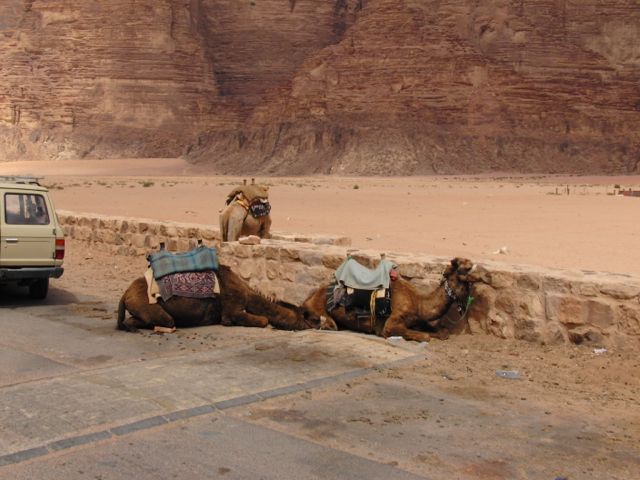 |
| Camels, on break |
Our first stop was at a Bedouin camp, but all we got to see up close and personal was one large tent (probably 200 square feet) that was closed on three sides that contained souvenirs. We were invited to come in and we sat on cushions which were on carpets that covered the red sand. We were offered tea but none of us took any. Frankincense was burning and it was rather peaceful to just sit there while looking at one of the large red pinnacles. Our guide gave each of us a Bedouin name. Filbert was given “Stawie” which means “listens to wife” and Snookums was named “Fatima” which means “speaks from the heart”. We thought they were accurate. The Bedouin camps that we could see in the distance all looked similar with their goat hair tents and one or two trucks.
We got back in the truck and drove to our next stop, Khazali Canyon. We were able to carefully scramble around 600 feet, starting on a ledge on the right-hand side, in order to see Thamudic inscriptions dotting the walls.
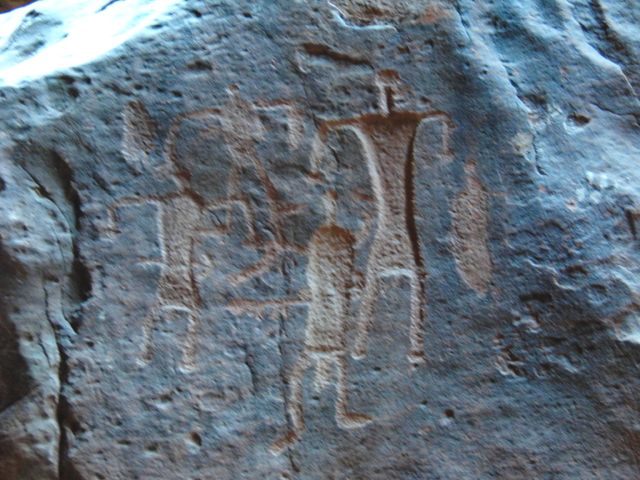 |
| Petra-glyphs. That’s a pun, son. (Possibly NSFW) (The picture, not the pun.) |
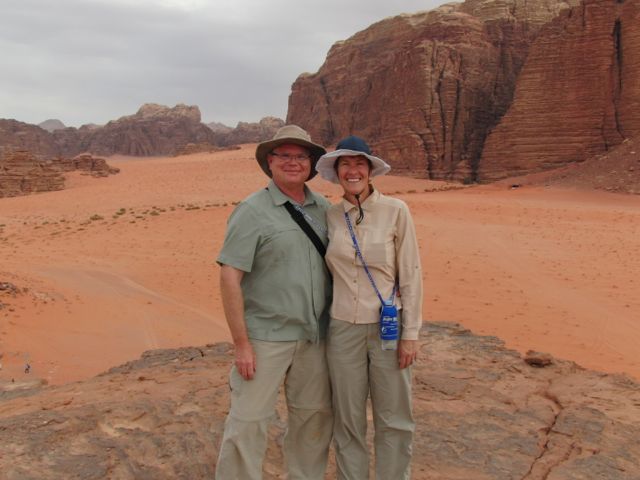 |
| On top of a rock. |
Then we went to a large outcrop and saw that 20 jeeps of people were there from the ship busy climbing up on it. It looked pretty high, but doable. Our guide, though, said we were going to climb a sand dune across from it. We thought he was kidding, but he was serious. So, we started climbing up the sand dune. It was extremely hard to do since the sand was so fine and deep. Snookums was following the guide and a third of the way up she had to stop to catch her breath. She looked behind and saw that Filbert was coming but didn’t know if he would continue since he has a bad knee and it was very, very, very tough to climb. She didn’t worry about Filbert and kept climbing the deep, steep sand. The next time she looked back she saw that Filbert was still climbing but didn’t notice where since she was so tired. She kept climbing and finally made it to the top of the sand dune and then climbed on top of the rock outcropping that was next to it. Then she saw that Filbert was climbing on the side of the sand dune that was connected to the rock and therefore he was climbing on the rocks rather than the deep sand and took the easy (and smart!) route up to the top. Stan followed Filbert’s lead and Renée followed Snookums’s. The men were smarter, that was for sure, but the women got a workout for the ages! From the top we saw that the people on the Oceania tour were on the top of their rock, but it was way down below our rock. We had a great view of this strange red landscape. And, we had shoes full of fine red sand and white socks that were now red. Going down was very, very easy as we all ran. Snookums was reluctant, but Filbert shrugged and chugged down. That’s why he was at the bottom to take this picture:
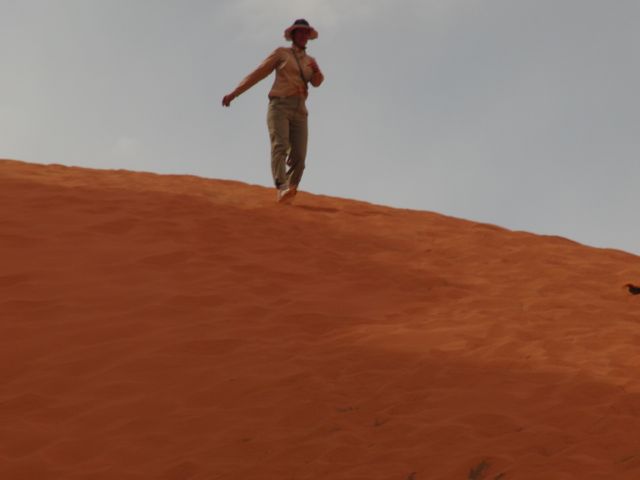 |
After our hike, we drove to Jebel Umm Fruth Rock Bridge which is a natural phenomenon that rises straight from the desert floor. Everyone hiked up and Stan and Snookums made it to the end of the rock bridge, but Renee and Filbert couldn’t get up the almost three-foot step up to the bridge but still had a great view of the desert landscapes.
Around 5 PM we left for the fifty-minute drive back to Aqaba. We were covered in red sand dust, and our shoes and socks were possibly permanently dyed red, and we were very tired but exhilarated from our great day.
Based on what little we saw, it looks like Jordan’s prices are similar to the U.S. A two bedroom unfurnished apartment in Aqaba, population 65,000, is around $500 per month. Gasoline is $5.50 per gallon. (It used to be cheaper than water until the Iraq War.) Aqaba, Jordan’s only port, is a special duty free zone and it sells alcohol. On the way back to the ship, the van stopped at a liquor store so Stan could by some Amaretto and Southern Comfort. Filbert bought some bottles of Italian wine for around $15 each.
May 7 (Monday, Day 32, Safaga, Egypt; 1 EGP = $0.17; $1 = 6.04 EGP) –
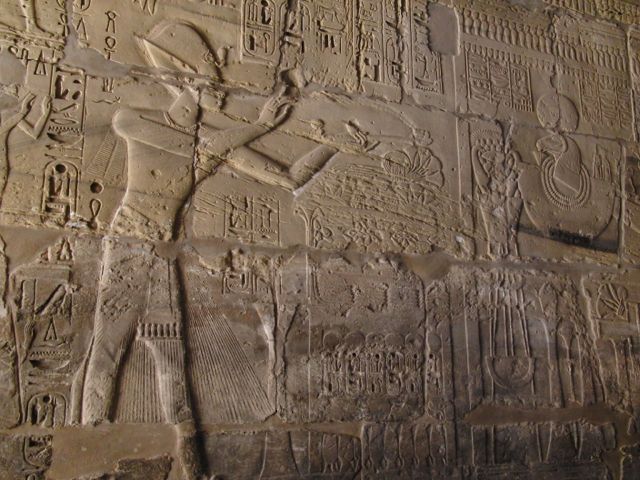 |
| Yup. Egypt. |
At 8 AM we joined Barbara and Donna for our private 4-person overnight tour of Luxor, Egypt. They live in Los Angeles in the summer and Hawaii in the winter. Barbara organized the tour with Ramses Tours and it cost $220 per person. The ship was doing the same tour and charging $700 per person and 200 people signed up for it. Riding with only three other people for a lot less money is a much more enjoyable experience as compared to being on a bus with 40+ people.
We literally were the first people off the ship and our driver was standing at the end of the gangway with a sign with our names on it. We got in the van and took off. Filbert had the back row of three seats, Snookums had the middle row of two seats and Donna and Barbara had the front row of three seats. Everyone was very happy. For two hours and 30 minutes we passed nothing but rocky desert and several checkpoints, but most of them seemed deserted. We didn’t stop at the one and only tourist stop. The last 30 minutes of the ride were more interesting since we reached the Nile Valley and there was green in the landscape, including crops. In fact, we saw the crops being harvested by hand. There were sheaves of wheat and we also saw a threshing machine and the wheat was being blown onto the field in a pile. Donkeys were being used to haul carts and we saw three tractors, including one on the road that was being pushed by three men. Since last year’s revolution in Egypt, gas has been hard to get and it’s possible that the tractor’s gas was being saved. We saw two gas stations in Luxor with long lines of tour vans and very few personal cars waiting. We also saw several gas stations closed since they didn’t have any gas.
We got to Karnak Temple ($10.50 per person, but all admissions were included in our tour price), the largest place of worship ever built, around 11 AM and realized that visiting this vast complex of 3,000 year-old temples built over a 2,000-year span during the heat of the day wasn’t the smartest thing to do. However, when you only have a short window of time to see Luxor, you bite the bullet and do what you have to do. The sun was very intense and there was not a cloud in the sky. The temperature was probably 105° and it gets to 125° during the summer months! Donna decided to sit in the shade and wait for the rest of us. Filbert, Snookums and Barbara traipsed around and listened to our guide, Amr, talk about Egyptian ruins. Our guide also told us that Luxor hasn’t had any rain for 2 ½ years!
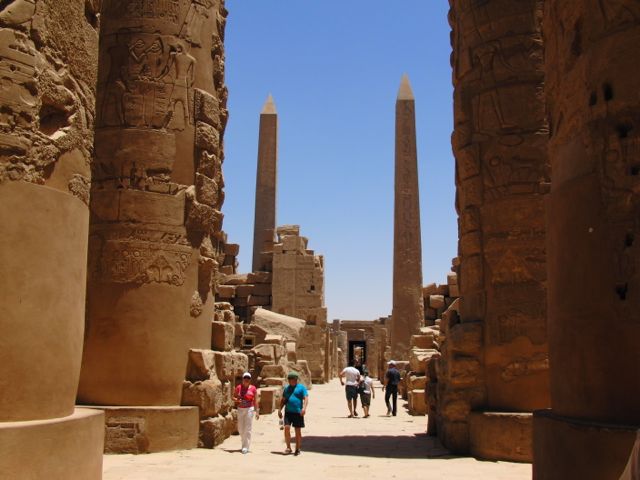 |
| Karnak Temple, Luxor |
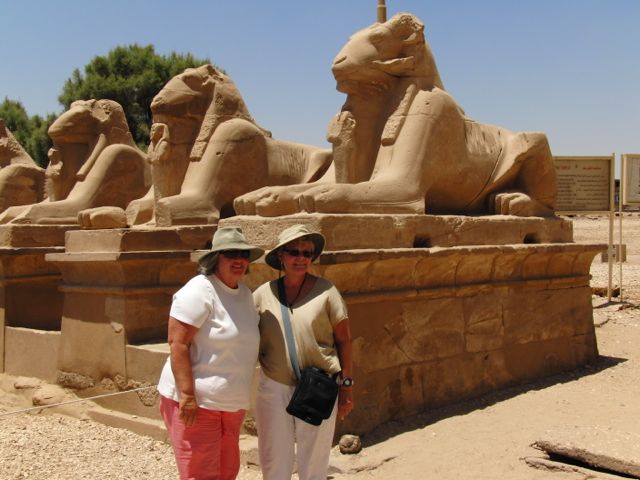 |
| Barbara and Donna |
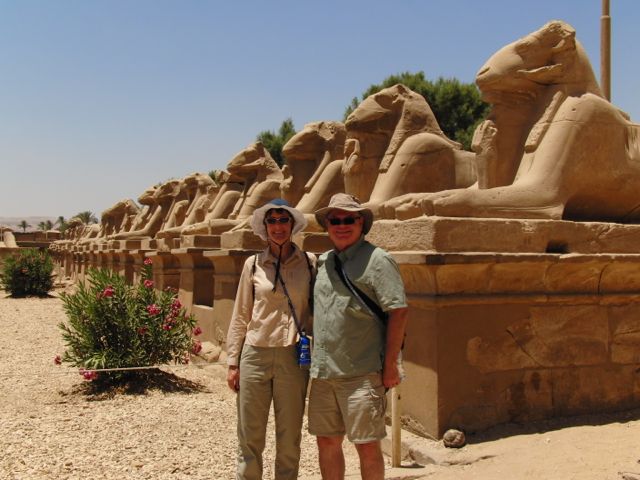 |
| Snookums and Filbert |
After getting very red in the face from the heat, we went to a so-so buffet lunch at Luxor Museum. (We didn’t get to see the museum.) The food was nothing special, but the stewed potatoes and the vegetables in the chunked up kebab chicken (bones and all) were okay. And, the room that we ate in was air-conditioned. The area where the buffet was displayed was air-conditioned, but not very well. After lunch we took a little boat to the west side of the Nile where the van was waiting to pick us up.
The 2012 Hong Kong-Athens Cruise, part 3 of 6
Contributed by: filbert Thursday, January 24 2013 @ 08:00 AM CST
Text and pictures by Snookums, webification by Filbert
Part Three
(April 28 (Saturday, Day 23, Mumbai, India; 1 INR = $0.02; $1 = 51.66 INR) –
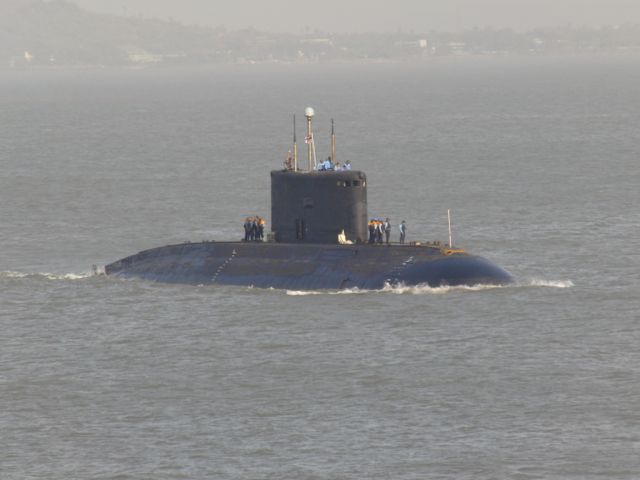 |
| Indian Navy submarine, out for a weekend cruise around Mumbai Harbor |
Since we are not that fond of India, we didn’t get off the ship. The ship left Mumbai at 5 PM. April 29 (Sunday, Day 24, Cruising the Arabian Sea) –
April 30 (Monday, Day 25, Cruising the Arabian Sea) –
May 1 (Tuesday, Day 26, Salalah, Oman; 1 OMR = $2.60; $1 = 0.39 OMR) –
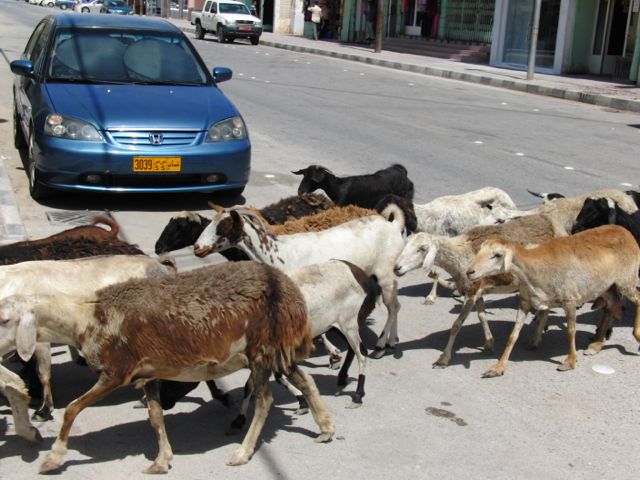 |
| Goat Crossing |
We woke up and got off the ship at 9:30 AM. We decided to take a taxi to the Museum of the Frankincense Land and then walk to Haffa souq (shopping area). A free shuttle had to be used to get out of the port since it was a large container port. We got off the shuttle and immediately were pounced upon by cab drivers. We looked at the printed price list at the gate and after talking to the head taxi dispatcher with his so-so English decided to just take a cab to the souq for 10 OMR ($26). Using the taxi dispatcher, we made sure the cab driver, who spoke very little English, understood that we wanted to go to an ATM and then the souq for 10 OMR.
We stopped at the ATM a few minutes from the port and then drove for another 15 minutes or so. There was a lot of sand all around and some grain elevators and not much else. We were definitely in a commercial port area. Then we started seeing a lot of sand colored buildings and some nice landscaping, including a lot of green grass and flowers. (Everything else was sand.) Our driver pulled over and we realized he was showing us the Sultan’s palace. We think the driver told us that he has one in Muscat, Oman and Rome, Italy, too. While Filbert was taking pictures of the palace, the driver asked Snookums if we wanted to have a tour with him for two hours for 20 OMR, including getting back to the ship. Well, since we were going to have to pay another 10 OMR to get back to the ship anyway, it seemed like a great deal so we said “yes”.
Our next stop was the Haffa souq. We got out of the taxi and wandered around a few open-air stalls that were mostly selling frankincense and the Omani national symbol, the silver-sheathed dagger known as the khanjar. We also saw a lot of arsaas for sale. An arsaa is a tribal walking stick with a concealed sword in it. Most of the vendors were men, but there were some women and they were wearing black robes from head to toe with just their eyes exposed. Some of them even had black chiffon veils over their eyes. We purchased three postcards in order to get some coins so that Snookums would have her souvenir. The vendor told her that the smallest coin was the cheap one. It was all in Arabic but since the other coin had a five on it, Snookums assumed it was a .01 OMR coin or worth $0.03. We walked out of the souq and passed a food stand and saw a man buy a huge piece of flatbread (larger than a tortilla, but similar) with a bunch of chopped meat on it. It looked delicious, but we had basically just eaten breakfast so we kept walking.
We turned down a street that must have been tailor’s row since every single shop was a “Gents Tailoring” shop that had one male employee in it, one or two sewing machines and at least 100 bolts of fabric. Oman men wear plain robes that don’t look like they require custom tailoring, but there must have been 100 tailoring stores. We saw a few for women, too. As we were walking along the desolate tailoring street in the hot, dry sun, a herd of goats crossed the street. There didn’t appear to be a shepherd or anyone with the goats. We passed a few little fruit stands, some laundries and some stores that were selling toys and little plastic junky things. Otherwise, we just saw a lot of tailors.
We wandered back to the souq and got in the taxi for our next stop, the Museum of the Frankincense Land. This is a set of ruins that belong to the 12th-century trading port of Zafar. From here, frankincense was shipped across the sea to India in exchange for spices. There was a nice new museum, too, and we learned that the current sultan of Oman came to power on July 23, 1970 and that is when Oman entered the “modern” world and started building its cities, including Salalah (current population 140,000).
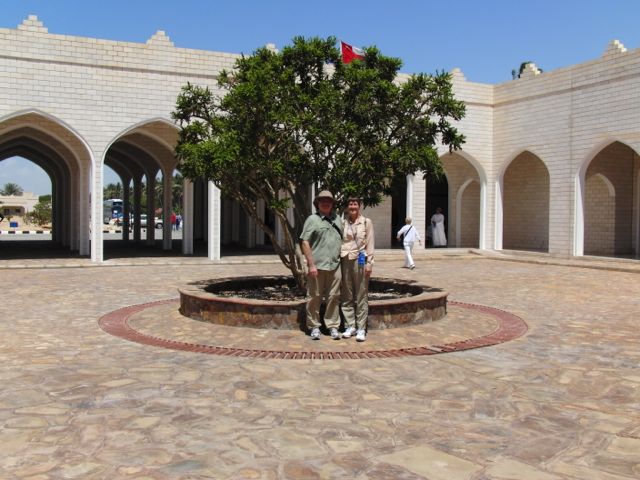 |
| In the Museum |
After seeing the museum, the taxi driver took us to the footprints of the Prophet Saleh’s camel. We didn’t know what this was, but it was on the map and we said “OK” when the driver pointed to it. Snookums wanted to see a camel so she was excited when she saw this open-air covered structure (like an animal’s pen at a zoo). Unfortunately, it was simply a protected bunch of dirt that had some hoof prints in it. Filbert and Snookums looked at each other and since the driver was excited about it, Filbert made a point of taking some photos. There was a sign in Arabic at the front of the structure. This structure was near some apartment buildings and some parking lots – just kind of in the middle of nowhere.
The taxi driver then stopped so Filbert could jump out and take a picture of a clock tower and then we went to the Grand Mosque that has five minarets to match the five pillars of Islam. It can hold 15,000 men and also has a room for 750 women.
Then we asked to go back to the ship and on the way stopped at LuLu Hypermarket which was a huge, brand new grocery store that was probably the nicest one Snookums had ever been in, including US grocery stores. Every product that could be found in the US and the UK was in this three-story store (except for Crystal Light!) and we bought a case of Diet 7-Up ($0.37/can) and four cans of Diet A&W rootbeer ($0.65/can). There was a whole section devoted to dates and date spread, too. When we were checking out a man bought what looked like a 5-quart pail of ice cream but was really 4 kg (8.8 pounds) of Dannon yogurt! On the way out of the store, Snookums had to buy some fresh caramel popcorn from the vendor out front for $1.30 – very pricy, but it was tasty.
We got back to the ship around 12:30 and freshened up just a bit before heading to lunch. It was a good day, especially since we did more than the ship’s $95 per person “Scenic Salalah” tour and only paid $61 total.
Dinner was at Polo Grill. Filbert’s lobster bisque was “off” so he didn’t eat it but Snookums ate her clam chowder and her Waldorf salad and then enjoyed her 14 oz. pork chop while Filbert ate his 12 oz. ribeye. Neither of us had dessert.
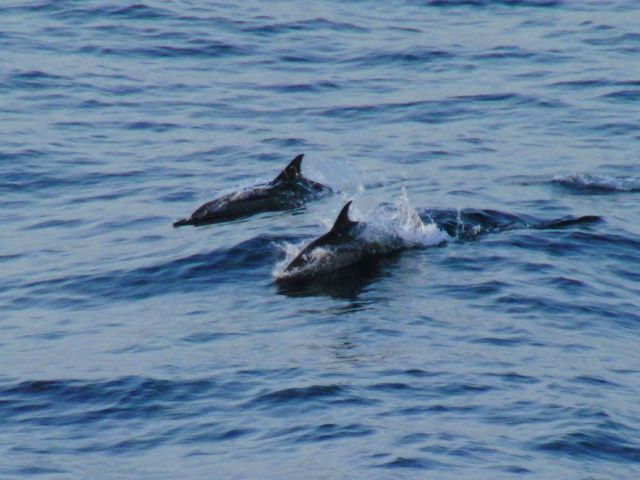 |
| Finally! Some dolphins! |
May 2 (Wednesday, Day 27, Cruising the Gulf of Aden)
For those of you wondering what there is to do during a day at sea, the following activities happened between 11:00 and 3:00 today:
11:00 – Beginners Bridge Lesson, Polo Grill
11:00 – Cellar Master’s Wine Sale, Upper Hall
11:15 – Food & Beverage Questions & Answers Session, Nautica Lounge
2:00 – Egyptian Cartouche Seminar, Martinis
2:30 – Black Jack Tournament, Casino
2:30 – Card-Making with Julie, Terrace Café
2:30 – Enrichment Presentation “Jordan: The Amazing ‘Yes I can’ Country”, Nautica Lounge
3:00 – Golf Putting Tournament, Sports Deck
May 3 (Thursday, Day 28, Cruising the Red Sea) –
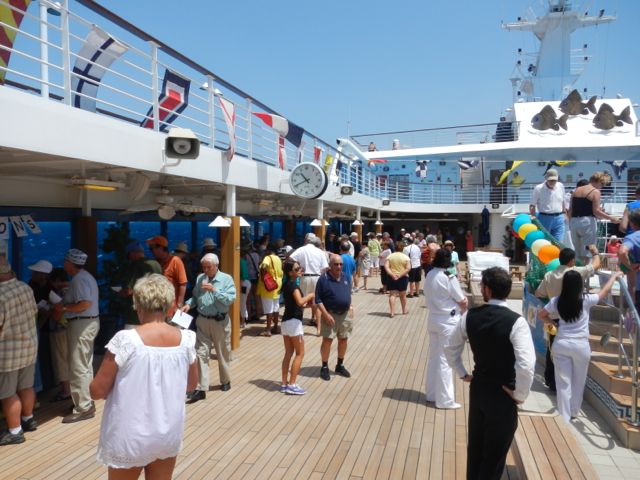 |
| Country Faire |
Today’s big event was the Country Faire. We’ve seen this on our other cruises that have several back-to-back sea days. Each department sets up a game on the pool deck and the passengers get to play the games and win raffle tickets. Prizes (bottles of wine, logo merchandise, etc.) are then given to the winning raffle ticket holder. Filbert and Snookums competed in the Boutique’s “dress the mannequin” contest. As the winner, Snookums won two tickets and Filbert won a ticket. Snookums then competed in Housekeeping’s “Put the pillowcase on the pillow” and she was the runner-up and got one ticket. Then Snookums went and bugged Barbara and Donna in their cabana that they rented for the entire cruise. (Barbara organized our upcoming tours in Luxor and Haifa.)
May 4 (Friday, Day 29, Cruising the Red Sea) –
Tea time today was in the Nautica Lounge (the showroom) rather than Horizons (the front of the top deck) since it was a fancy tea. It was kind of like the chocolate extravaganza that Holland America has but had more varieties of sandwiches than the normal tea and had more sweet choices. There was a long line to get in. By the way, Oceania’s normal high tea (daily at 4 PM) is very good. It beats Holland America’s afternoon tea hands-down.
May 5 (Saturday, Day 30, Cruising the Red Sea) –
We woke up and Filbert decided to wash his sleep apnea face mask and hose which he has done several other times on the cruise. Like normal, he left the pieces on a white bath towel on the table in the room. When we returned from breakfast, our room had been cleaned and one of Filbert’s two face masks was no longer on the table. (Filbert travels with two in case something happens like this.) He called the front desk and Security came to the room and met with him. He explained that Housekeeping threw away (or whatever) one of his face masks and Security told him that a lost/stolen form would be delivered to him today or tomorrow.
There was an Arabian Nights “event” on the 5th floor starting at 9 PM. Each revenue-generating department did something special. The bars had drink specials, there were free hand massages from the spa, and there were sales at the boutique. We didn’t go.
May 6 (Sunday, Day 31, Aqaba, Jordan; 1 JOD = $1.41; $1 = .71 JOD) –
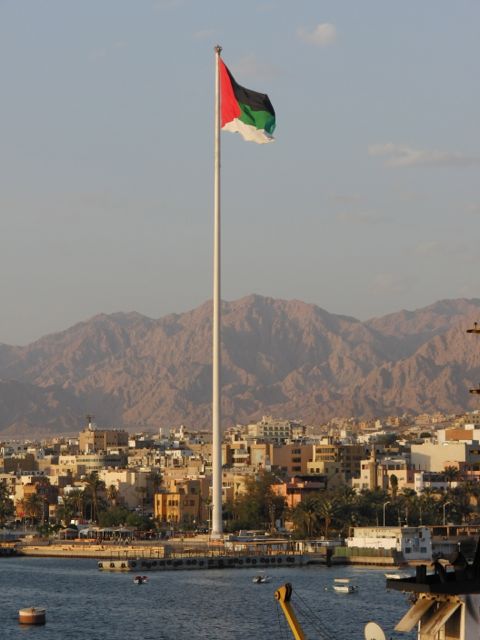 |
| The Big Flagpole |
At 7 AM we met Stan and Renée, from Park City, Utah, and found our Via Jordan Travel guide, Ashraf H. Alnawafleh. (We booked this tour with www.viajordan.com and by having four to six people on it, each person only had to pay $204. Oceania was charging $495 for a Petra/Wadi Rum tour on a huge tour bus.) Snookums was disappointed to see the guide and driver wearing Western clothing and realized that a lot of Jordanian men wear Western clothing although the robes are also frequently worn. Women mostly wear full robes, although we also saw many just wearing a head scarf along with Western clothes.
The four of us were in the back of a comfortable van and headed out to Petra, two hours away. Along the way we saw many Bedouin camps with herds of goats and some camels. The Bedouin tents are made of naturally water repellent goat hair that the women weave.
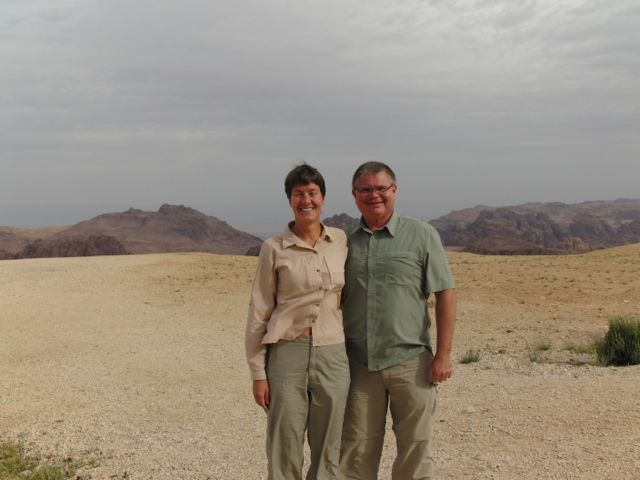 |
| Somewhere in Jordan |
Luckily the four of us got to Petra ($70 per person entry fee) before the tour buses did and it wasn’t too crowded. (The Azamara Quest was also in port and it is an identical ship to Oceania’s Nautica.) We started walking through the Siq, the ancient main entrance to Petra. The Siq is a ¾ mile long, deep and narrow gorge of stunning natural beauty. Cliffs soaring up to 265 feet hem it in. We saw bizarre-looking geological formations, colorful rocks, agricultural terraces, water channels cut into the cliffs, dams and votive-niches carved into the rocks. The Nabataeans, ancient Arab tribes, created all of this more than 2,200 years ago originally from the Arabian Peninsula. By the 1st century BC, Petra was a city that supported 30,000 Nabataeans and Petra had a lucrative position on the spice and incense trade routes from East Asia and Arabia to the Mediterranean. Key to the Nabataeans’ success was their ability to control and conserve water. Petra was gradually abandoned, primarily due to earthquakes, and after the 14th century was completely lost to the West, until a Swiss traveler rediscovered it in 1812. Our guide told us that his family has been from Petra for 15 generations. In fact, his father was born in one of the caves that was originally carved as a tomb. (Around 300 people still lived in the caves as recently as 1985 when the Jordanian government relocated them to a new village on the edge of Petra.)
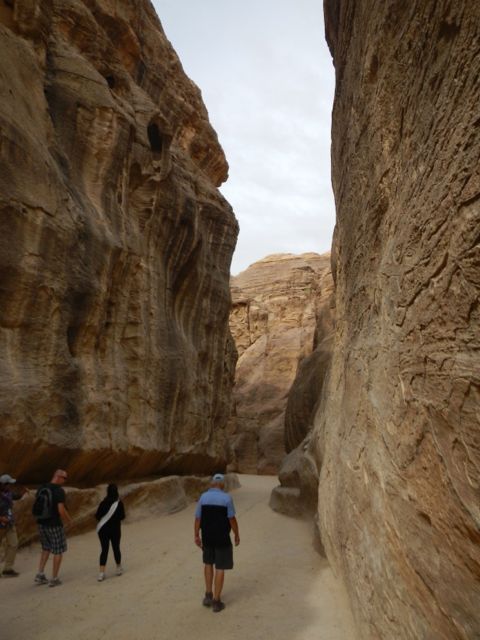 |
| The Siq |
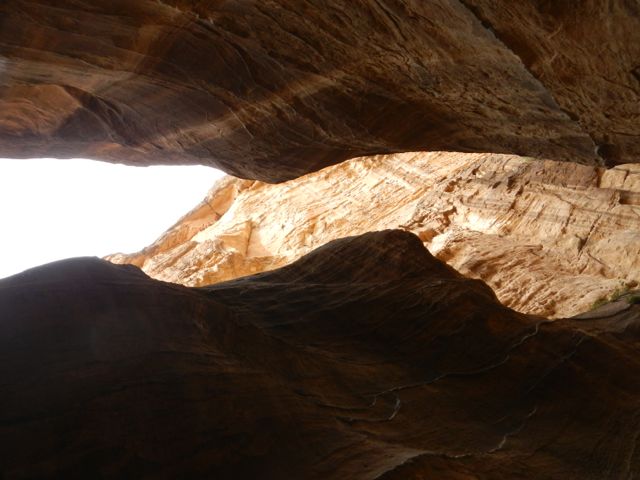 |
| It got narrow (looking up) |
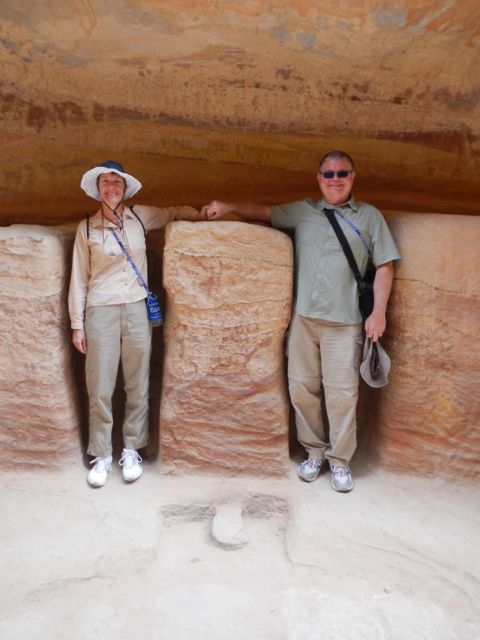 |
| I don’t remember what this pose was about |
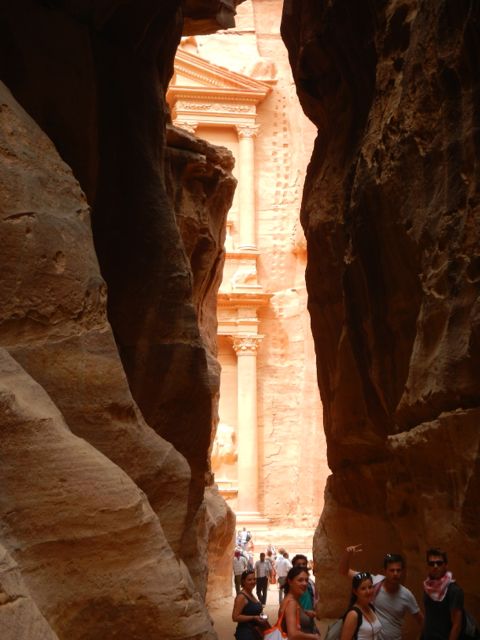 |
| Emerging from the Siq |
As we emerged from the Siq, we suddenly came face-to-face with the Treasury, the pride and joy of Petra. Its elaborately carved façade is 100 feet wide by 140 feet high. It was carved in the first century BC as a tomb for an important Nabataean king.
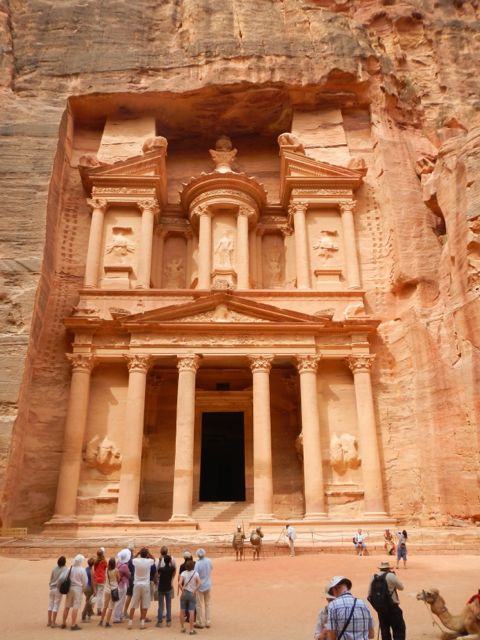 |
| The Treasury |
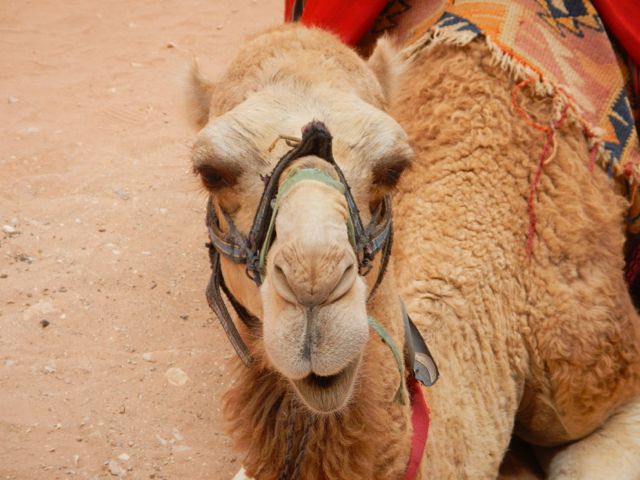 |
| What are YOU looking at? |
The 2012 Hong Kong-Athens Cruise, part 2 of 6
Contributed by: filbert Wednesday, January 23 2013 @ 08:08 AM CST
Text and pictures by Snookums, webification by Filbert
Part Two
April 21 (Saturday, Day 16, Phuket, Thailand; 1 THB = $0.03; $1 = 30.81 THB) –
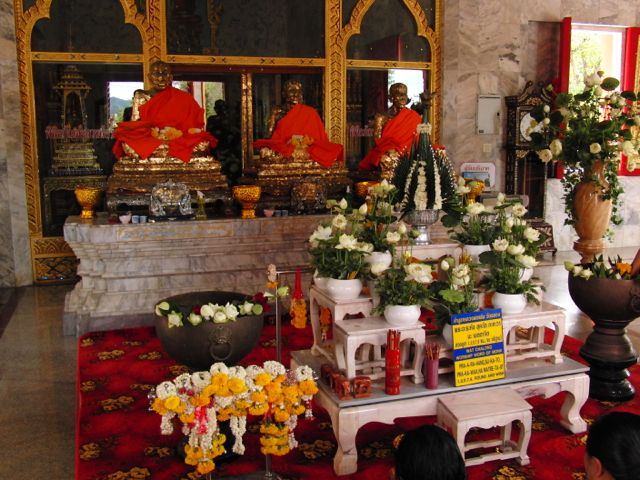 |
| Shrine |
Snookums woke up, showered and almost fainted. She had to sit on the toilet until the bright white lights dimmed. Snookums returned to the doctor at 8 AM for another temperature check and her temperature was normal but her blood pressure was 85/62 which is very low for her. She still didn’t feel well, either, and decided not to go on the Phuket tour. Filbert and Snookums had booked a Phuket tour with six other people and Filbert went since it needed to be paid for and there was nothing he could do for Snookums. Snookums stayed behind and watched movies. (This was the one tour that Snookums really wanted to do on the cruise since it involved riding an elephant.) Wat Chalong:
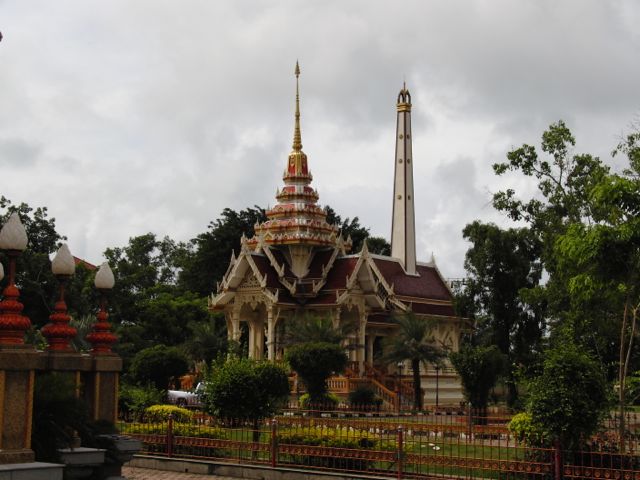 |
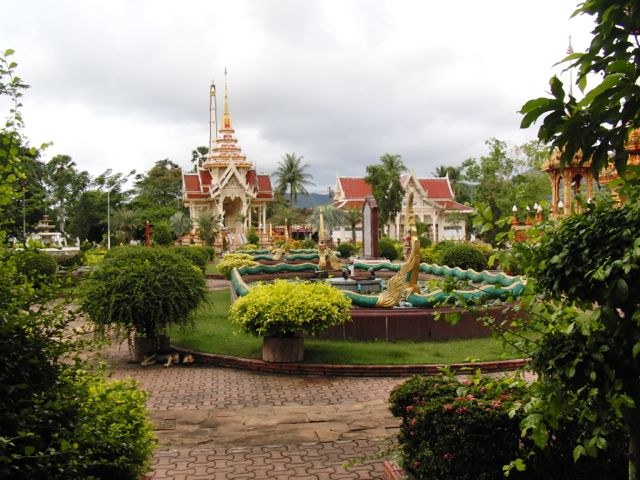 |
Filbert talked to the Premier Phuket tour leader right away and was not charged for Snookums’s no-show which was really nice. For $90, Filbert enjoyed the following places: Wat Chalong Temple, the Big Buddha, Prom Thep Cape which is the rocky headland that juts out into the sea at the far southwest of Phuket and has a nice view, an elephant ride and snake show, lunch at Baan Chom View Restaurant, and shopping at OTOP market in Patong (he didn’t really enjoy the shopping stop and said it was the normal tourist junk).
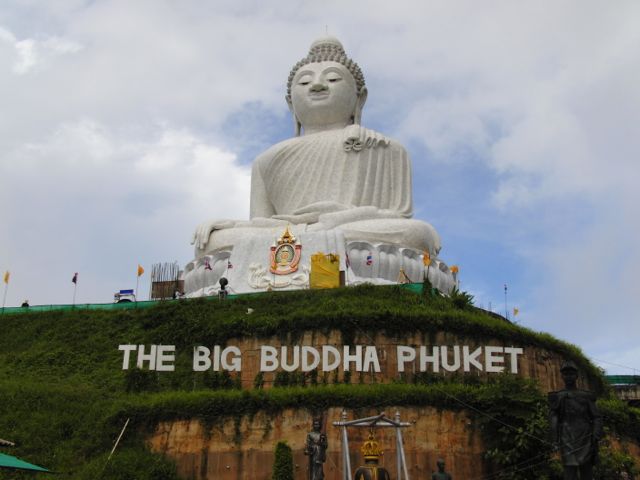 |
| The Big Buddha |
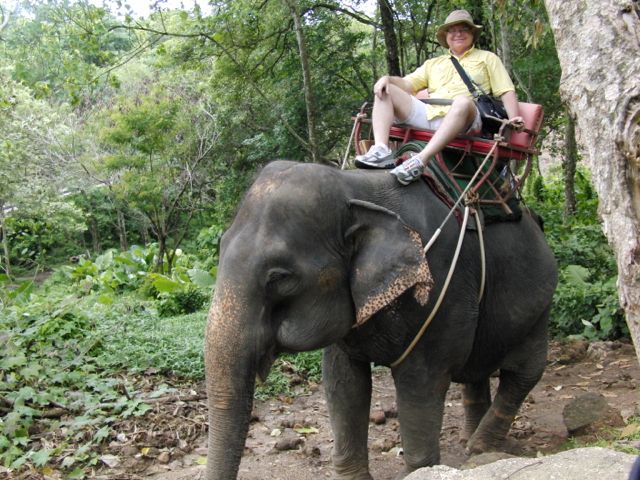 |
| The elephant’s the one with the four legs |
Filbert learned that Phuket has a registered population of 30,000 and if seasonal workers are included, the population is around two million. 70% are Buddhist and 30% are Muslim. Tourism is Phuket’s main industry.
Filbert returned to the ship around 4 PM and found Snookums in bed with her headache. On his elephant ride Filbert bought Snookums a $10 elephant necklace from the mahout. (He figured it was the mahout’s tip.) Snookums thought it was nice, although neither Filbert nor Snookums are sure how to get it on since it is very tiny, but too big for a bracelet. Maybe it’s a child’s necklace?
Filbert went to the ship’s store and bought Tylenol ($8.99) for Snookums since she was still unable to convince the doctor to give her any. The doctor insisted that the other two ingredients in Comtrex (the decongestant and the antihistamine) were needed to fight her virus! Snookums threw away the Vitamin C tablets. What a quack….. And, to add insult to injury, the bill for Snookums’s doctor visit was delivered to the cabin today — $641! It’s a good thing we have trip insurance!!
April 22 (Sunday, Day 17, Cruising the Andaman Sea) –
April 23 (Monday, Day 18, Cruising the Bay of Bengal) –
We attended the lecture given by Captain Leo Strazicic about modern day pirates. We learned that from the time we leave Mumbai, India until we dock at Aqaba, Jordan, we will be in a High Risk Area. While sailing through the High Risk Area, our ship will be in permanent contact with the International Task Force, including U.S. and U.K. naval forces that are assigned to protect merchant vessels from pirate attack by a United Nations mandate. While in the Gulf of Aden (the most dangerous part), our ship will be passing through the area using an internationally approved transit corridor. Additional security personnel will join the ship in Mumbai, fire hoses will be rolled out on Deck 5 and outside lights will be turned off at night in order to reduce the ship’s external lighting. It was very interesting and no one is worried.
April 24 (Tuesday, Day 19, Cruising the Bay of Bengal) –
April 25 (Wednesday, Day 20, Cochin, India; 1 INR = $0.02; $1 = 51.66 INR) –
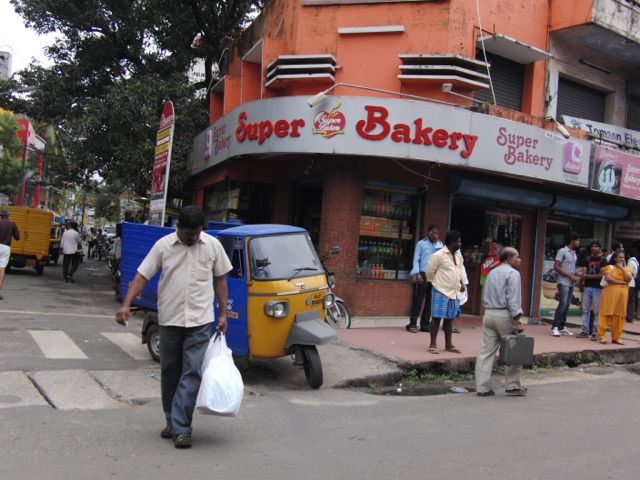 |
| This photo brought to you by the Medical Tourism Board of Cochin |
We had been to Cochin before and had pretty much decided to not get off the ship. However, as we started docking, Snookums decided that maybe seeing a doctor would be a good idea. (Filbert had mentioned it the night before but Snookums said “no”.) Snookums was still dealing with a headache and mild nausea and just wasn’t having a very good time and finally decided to see what was going on. We went to the Executive Concierge to get the name of a doctor and he wanted us to talk to the ship’s doctor. We explained that the ship’s doctor was an idiot and we didn’t want to get any information from him. The Executive Concierge went to the port agent and came back with a doctor’s name and location (but not an address since Cochin must not have addresses) for us.We got off the ship and the cab drivers immediately descended upon us. We showed the paper to them and one guy said “$50”. We said “no” and kept walking. Then someone said “Not $50, $15.” Well, $15 sounded better so we said okay and got in a cab. The driver drove for at least 20 minutes and finally turned down this little alley and stopped the car. The cab driver didn’t speak much English but he got out with us and pointed to the “clinic”. We saw anchors on the door and a sign that had the doctor’s name on it. We waited outside under the carport for around 15 minutes and then were motioned inside. Snookums explained to the doctor, who was sitting at an office desk in the one room that we could see, that she had a bad fever and now still has a headache and mild nausea. The doctor said that Snookums needed to see an internist and that she needed to see a female doctor so that Snookums could tell the doctor her “other problems”! Well, Snookums didn’t have any other problems but she wasn’t surprised that she would be pawned off on a female doctor since this was India after all.
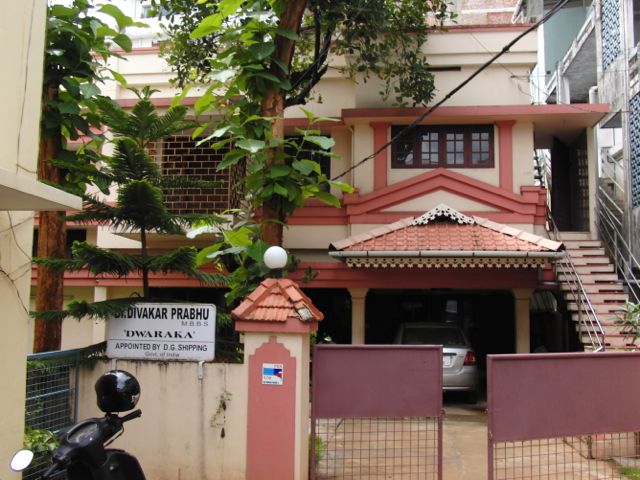 |
| A Trip to the Doctor’s Office |
By the way, it appeared that this male doctor was a doctor that specialized in getting paperwork approved for Indians who wanted to work on ships. That’s why there were anchors on his door. We didn’t see any exam rooms but his outside waiting room was full of men that would meet with him and then leave holding a piece of paper. He probably was a real MD, but didn’t really practice like one.
He made a phone call and then told us that he made an appointment for us with a female doctor and that we needed to take his office boy with us and he would show the cab driver where to go. So, the cab driver drove the office boy and us to the Medical Trust Hospital in Cochin. (We learned later in Mumbai that a trust hospital is a public hospital and most Indians go to private hospitals.) The cab driver needed $1 for parking the car in the hospital’s dirt parking lot and then the office boy led us into the hospital and a small room that said “International Patients” and Snookums filled out some basic paperwork. Then the female office worker said “220” and we didn’t know if she meant dollars or rupees. She meant 220 rupees ($4.25) and this 220 rupee bill was split between 150 rupees ($2.90) for the doctor’s consultation and 70 rupees ($1.35) for the registration charge. We had no rupees so a “candy-striper” took us to the ATM on the second floor. While we were making the short hike, we passed tons of people as well as a large cart full of lunch trays. They were all hermetically sealed and looked like the type of hospital food that you would get in a US hospital. Snookums was impressed by what she saw.
After we got our rupees, we returned to the small office and paid our 220 rupee bill. Then we were taken to the doctor’s office. However, the doctor wasn’t ready to see Snookums yet so we waited in a large waiting room that was FULL of Indians. Filbert and Snookums stuck out like a sore thumb since all the other people were Indians. The waiting room was surrounded by the doctors’ exam rooms and every now and then some of the Indians would get up and go into one of the exam rooms. We never figured out how they knew when it was their turn, but they did. After 15 minutes or so, the candy-striper said it was Snookums’s turn and apologized profusely for the wait. We know that we were being put to the front of the line and didn’t mind the wait at all. Snookums and Filbert entered the exam room and found a female doctor behind a desk and two cheap plastic patio chairs on the other side. We sat down and the doctor said something and the office boy (from the first male doctor) and the candy-striper left. The nurse stayed in the room. Snookums explained her symptoms along with the two bug bites that she received in Bangkok. The doctor used an old-fashioned large metal flashlight (like Snookums used to take on her Girl Scout campouts before the era of plastic flashlights) to look in her eyes and her throat. Her blood pressure was taken, too, as was her temperature (via a thermometer placed in her armpit since that way it wouldn’t need to be sterilized!) while Snookums was sitting on the exam table with fabric sheets covering it (and not throwaway paper sheets). The doctor said that she wanted blood to be taken and would test for Dengue fever but she thought everything was fine and wasn’t going to prescribe anything. The doctor explained that it would take three days to get the lab results and when Snookums explained that the ship was leaving in a few hours and suggested that the results be emailed to her, the doctor agreed.
The candy-striper then took Snookums and Filbert to the blood work office and Snookums had to give a total of 659 more rupees ($12.76) for: Dengue fever antibody (600 rupees – $11.61), platelet count (50 rupees – $0.97) and single-use syringe (9 rupees – $0.18). After paying, Snookums went into the blood work room and a woman took her blood. The office worker at the desk hand labeled the two test tubes that would hold Snookums’s blood. After the worker took Snookums’s blood, she put the syringe with the blood in it in this rusty little box and then sparks came out. She removed the syringe from the box and Snookums saw that the single-use syringe was bent out of shape. Snookums thinks that the rusty little box was actually a grinder that ground off the syringe to prevent it from being used again. That’s what poverty is all about! The woman then poured the blood into the two hand labeled test tubes and put a Band-Aid on Snookums’s arm. Snookums, Filbert and the office boy returned to the international patients office and Snookums was given her official Medical Trust Hospital registration card (like a credit card) and was told that her lab results would be emailed to her. The office boy called the cab driver and we got in the cab to take the office boy back to the first doctor.
The office boy wanted Snookums to meet with the male doctor so she told him what happened and he wanted to make sure she understood that the lab results would be emailed to her. After five minutes or so of the male doctor talking about irrelevant things, Snookums said “thanks” and left. She expected to have to pay the male doctor something and figured that is why the office boy wanted her to see the male doctor again, but that was not the case. The office boy was with us for at least one hour plus Snookums “saw” the male doctor and there was no charge for any of this at all!
We got back in the cab and told the driver to take us back to the ship. The driver really wanted to take us on a tour but Snookums kept saying “No, I’m sick”. She wasn’t feeling bad, but she had no interest in seeing Cochin. We weren’t sure if our original $15 quote for the cab ride was one-way or round trip, but given that the driver was with us for around 3 hours, we decided to give him $30 when we got back to the ship just to be safe. What a day. We spent $30 for a cab and $18.01 for doctor visits and lab work. Only in India!
April 26 (Thursday, Day 21, Cruising the India Ocean) –
The pirate drill was today but we told our room stewardess we weren’t going to do it since Snookums still wasn’t feeling 100%. At 10:30 AM, the drill occurred and people had to go to corridors and stay low in order to not fall if the ship had to make sharp turns to get away from pirates.
April 27 (Friday, Day 22, Mumbai, India; 1 INR = $0.02; $1 = 51.66 INR) –
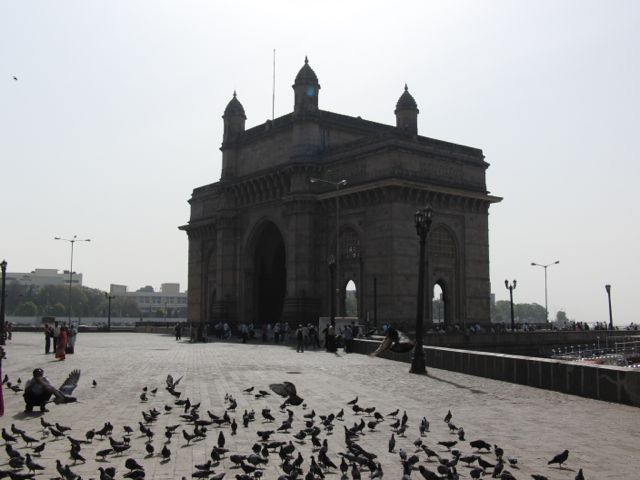 |
| Mumbai |
We met our guide, along with another couple from another ship, and immediately drove to the Taj Mahal Palace Hotel which is located across from the Gateway of India. We had seen this before and weren’t too interested. But our guide wanted us to see the memorial to the people that died during the November 26, 2008 terrorist attacks so we went in the hotel. Then we drove to the Dharavi slums, an area half the size of New York’s Central Park, occupied by around 1 million people. This area contributes anywhere from $500 million to $1 billion to Mumbai’s economy.
We started our walking tour by seeing several recycling programs. A dark, single car garage-like structure had six or seven workers squatting in a row while passing trash down the human/manual assembly line. These workers were dwarfed by a huge mound/wall of garbage that reached the tall ceiling. The first person would take out specific types of recyclables and then scoot the garbage to the next person who would do something similar. It was kind of amazing to see this. We went to another recycling place and this one was only for women to work in since some of them don’t feel comfortable working so close to men due to their religious beliefs. (30% of Dharavi residents are Hindus and the rest are Muslim.) Then we went to a bakery where the rolls were stacked out front in wooden crates with flies and things crawling on them.
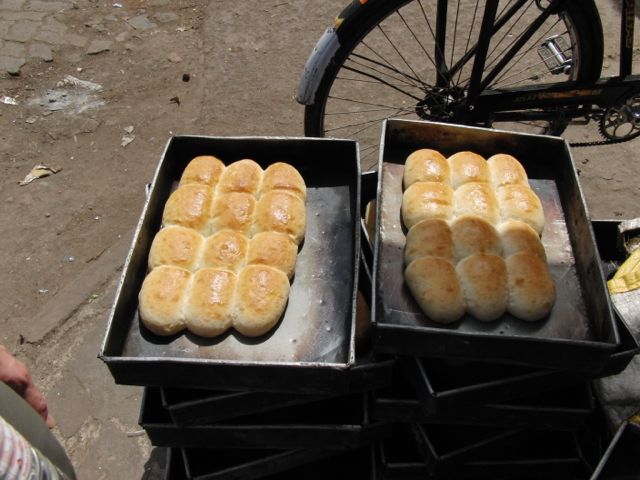 |
| Fresh bread! Hold the flies! |
Most of what is produced in the slums is sold throughout Mumbai (and the world) at leading establishments which is why photos aren’t always allowed. Indians don’t want people knowing where some of the Indian goods are coming from. After the bakery we saw a cardboard recycling shop that contained huge bundles of cardboard and some of it seemed to have been somehow made into “wood”. Most of these places didn’t have any machinery. The bakery had a wood-burning oven. We weren’t sure what happened to the sorted mounds of recyclables but six or seven workers were working in each small recycling shop. We also saw an oil can recycling shop and this had four girls squatting and using awful smelling chemicals to scrub the labels off the huge oil cans. The chemicals were definitely caustic and couldn’t be healthy and made our eyes run but the girls didn’t have any kind of protective gloves or masks. Our guide told us that after the oil cans were cleaned they would be refilled with cooking oil and sold. She said that the street vendors often use this kind of oil and that’s why people sometimes get sick from eating Indian street food. Reputable restaurants buy sealed news cans of cooking oil to use.
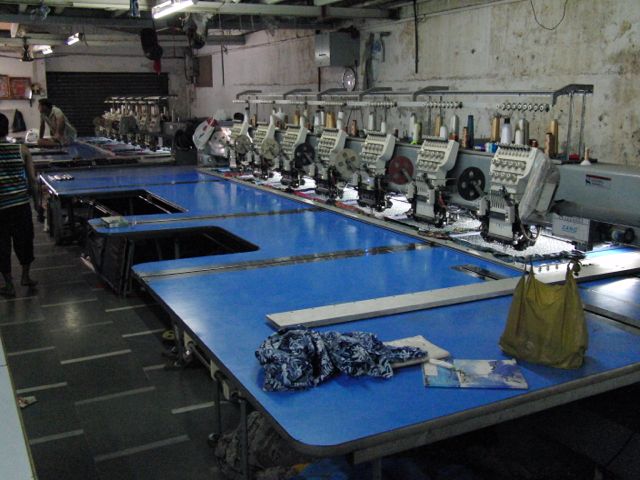 |
| Sweatshop |
We kept walking through narrow alleys and some of the buildings (definitely slums – there was no rhyme or reason as to how they were built) appeared to have the industry on the ground floor with living space on the second floor. There were also some buildings that just housed families in what looked like single rooms and a kitchen. Kids seemed to be everywhere and no one minded them. Scooters would drive through the alleys where the kids were playing cricket and where women would walk with pottery on their head. You definitely had to be awake to make sure you weren’t in the way. And, it was sunny, humid and 97° and not comfortable at all.
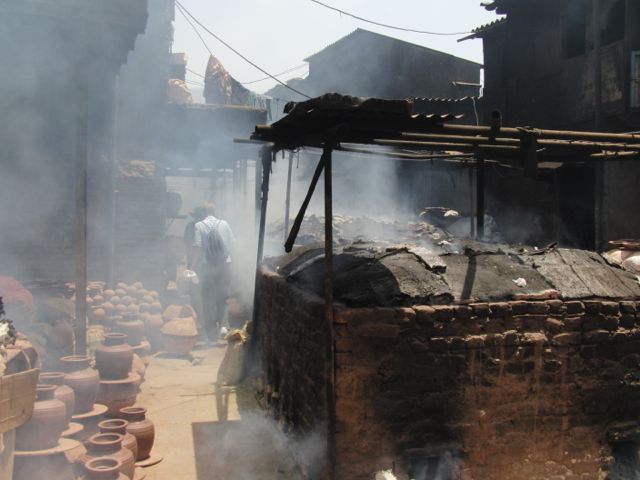 |
| Slum kilns |
We also saw several places that had ten people using sewing machines to make blue jeans and another place that had ten men making frilly dresses. We were taken into these one room places and had to step over fabric, food, and finished products. Stuff was just everywhere. Snookums saw a mouse running in one of the places and we all saw a slowly dying rat in an alley. Sanitation wasn’t a high priority and there didn’t appear to be any indoor plumbing since we saw one man brushing his teeth in the alley with a wash basin of water.
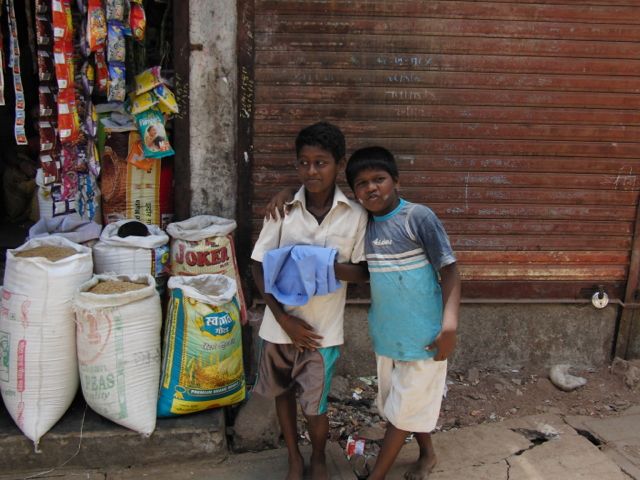 |
| Slum kids love to have their pictures taken. I don’t know why. |
We then walked to the section of Dharavi that was the leather tannery section and saw a few men tanning leather. None of these operations were big. The frilly dress place had ten men working in it but it seemed like the other industries had less than five or so employees. We also saw the area where several pottery places were in business. It didn’t seem like any of these industries were selling any of the products to the locals. They appeared to be strictly wholesale. Even the bakery seemed to be making its rolls to sell to one buyer.
One of the last industries that we saw was the pappadam area. This was where women were given pappadam dough each morning and they would squat in front of their homes and roll it into flat, plate-sized shapes and then put them on drying racks and let them bake/dry in the sun. The women didn’t wear gloves and the drying racks weren’t protected. It should be noted that there were dogs running around, too. Our guide said that basically all of the pappadam bread that is eaten in Mumbai is made like this in the slums and this was one area where absolutely no photos were allowed. After seeing it, we weren’t going to eat any pappadam!
By now we were all very hot and sweaty and piled back in the air-conditioned car. The driver took us back to the port and the other couple left. Filbert and Snookums stayed in the car since Snookums really wanted to buy mojari shoes. She bought a pair in Hyderabad, India when they visited Snookums’s sister there several years ago and she wanted more. The guide took us to Colaba, which is the unofficial headquarters of Mumbai’s tourist scene with lots of touts, stores, stalls, hotels, a movie theatre and even a McDonald’s. We went into a couple of fancy shoe stores like you would find in the U.S. but the shoes didn’t feel right. As we walked down the street, the guide would stop at various shoe places and ask, in Hindi, about the shoes. She finally found a little stall that was literally built on either side of three exterior steps leading into a building. This is where Snookums found two pairs of mojaris for around $12 each. Even though we had the guide for another hour or two, we asked to return to the ship where we showered and put India behind us.
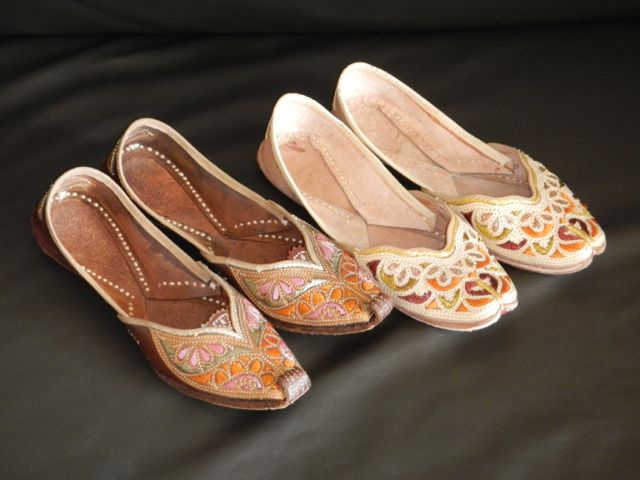 |
| Mojari shoes |
Snookums wanted to see dhobi ghat, the world’s largest outdoor laundry (all manual labor, of course), but she was tired and hot and called it a day. It had been a hot day and Filbert thought it was depressing. Snookums was amazed that people can live and work like that and have such a positive attitude. Our guide kept saying that they work hard in order to improve their lives and that is definitely what we saw. When we were in Rio de Janeiro, Brazil we visited its favelas (slums) but they were much nicer than Mumbai’s.
The 2012 Hong Kong-Athens Cruise
Contributed by: filbert Tuesday, January 22 2013 @ 02:38 PM CST
April 6 – May 14, 2012
Text by Snookums, Pictures and Webification by Filbert
This is the table of contents for the online version of our trip journal. Here are the chapters:
ATTENTION: LINKS BROKEN
